 By Marty Staz By Marty Staz
January 6th, 2020
BURLINGTON, ON
From everything we read, although still little of what we see, it would appear that 2019 has brought the kind of change to our City that we all expected when our new Council was elected. I’m talking about how our City will grow.
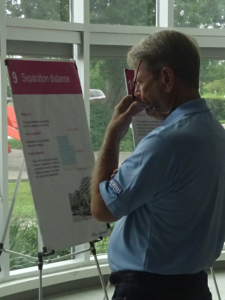 Staz looking over mid rise development guidelines released by the Planing department. But the question that I believe stands in the forefront, is it the kind of change that we need and want, and have the property alternatives for growth really been considered? I realize it was too late for three monster buildings downtown, but we still hear of the same thing being the main topics of discussion at City Hall, and now there is talk of approving a 27 floor tower on the football at Lakeshore and Martha in return for a small piece of parkland. The truth is all we ever hear of is high rise towers being the solution to our growth. We can’t even consider single detached homes being part of our growth solution.
We saw a grand total of 495 newly built detached homes in our City in 2019 which doesn’t come close to addressing the problem.
What about the “Missing Middle”? This is something I have advocated for in the past and it is something that should be considered as a solution to our population growth. It would provide mid-range and affordable housing and put the brakes on turning our City into a maze of high rise tunnels.
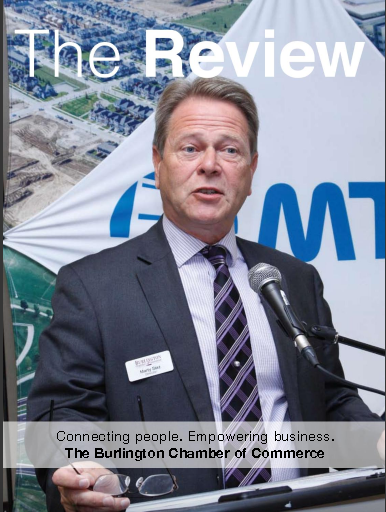 Marty Staz a Chamber of Commerce member most of his professional life. In a study done by Evergreen and the Canadian Urban Institute, the Missing Middle describes a range of housing types between single-detached houses and apartment buildings that have gone ‘missing’ from many of our cities in the last 60 to 70 years. The difference for Burlington is that we are in the process of creating a City that WILL be losing its middle, and at our current rate a lot faster than 60-70 years.
To clarify, what I am really talking about is homes that range from town-homes, 4-6 storey apartment buildings, laneway homes and triplex, fourplex type of homes. Homes that are capable of providing the 3 bedroom homes that growing families will need. Go ahead and look at the proposals of the towers currently approved and see how many units provide anything over 2 bedrooms. Go ahead and ask the future generation of homeowners where their ultimate dream home lies.
It is definitely not on the 24th floor with 2 bedrooms. They want to be able to walk out their door to their driveway or to a backyard.
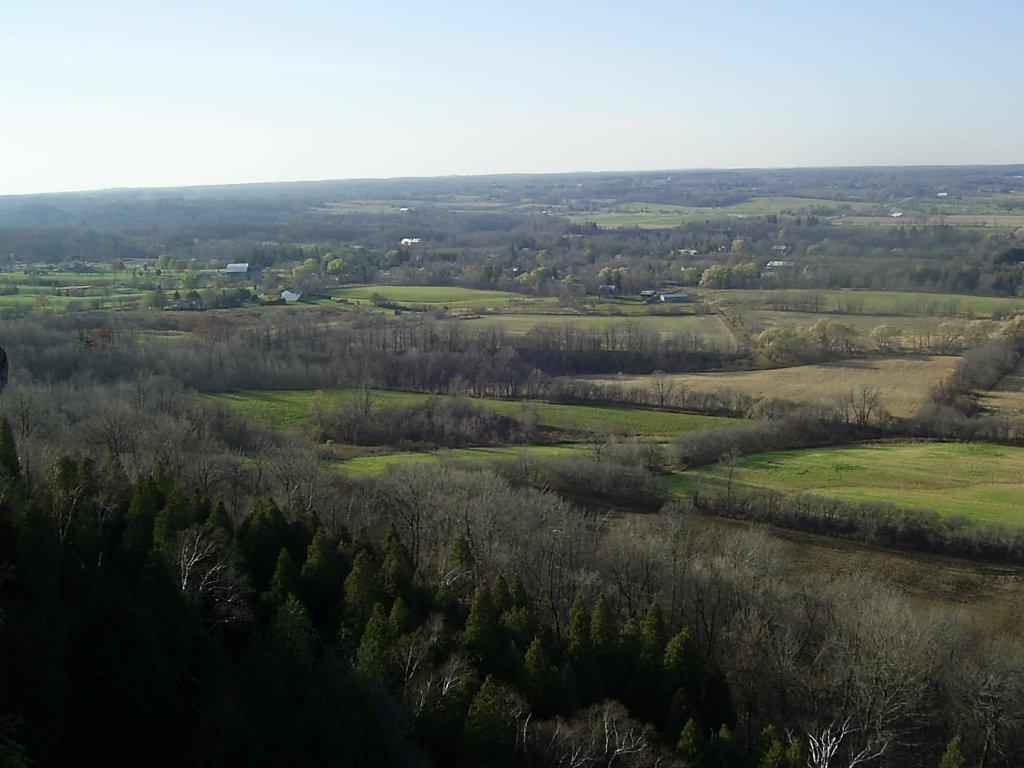 The Green Belt in the Escarpment does not permit residential housing except in the settlement areas of Lowville and Kilbride and even there development is very limited. Half of Burlington’s land mass is zoned rural. No affordable homes in this part of the city. The other consideration is affordability which must include a balanced mix of owned and rental homes. Of course a big challenge for our City is that land prices in our area, since we are land locked by the Greenbelt, are certainly not coming down. This is the argument many put forth to give credence to the high-rise solution. It’s going to take everyone from the public, private and non-profit sectors to come together to take a much deeper dive into how our City looks in the next 50 years.
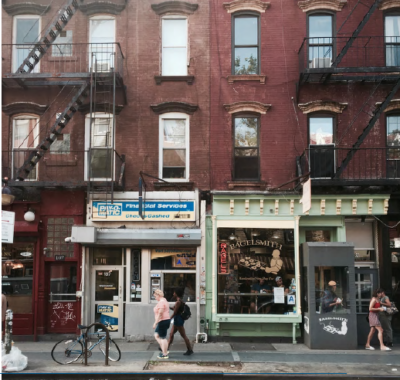 Good housing in stable neighbourhoods – and affordable. 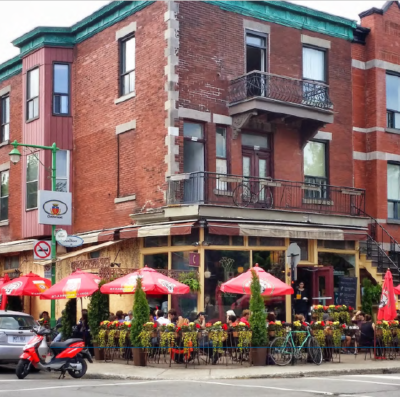 Housing has to be within a stable community – and affordable. The bottom line here is that our City is at a crossroads. We have already stepped across the line. Before it’s too late we need to make some hard decisions that will make people want to stay in our City and move to our City because they see a better place to live. Isn’t that what Burlington has always been about?
Marty Staz retired from the printing business got into real estate and then found himself a candidate in the October 2018 municipal election as a candidate in ward 1. He is an active member of the Chamber of Commerce
Background link:
The Missing Middle report: Click here

 By Pepper Parr By Pepper Parr
January 2, 2020
BURLINGTON, ON
The doors to city hall were open this morning – it isn’t certain that a full complement is in place to get the wheels turning.
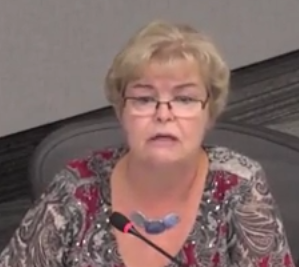 Joan Ford, City Treasurer, led a team that brought forward a budget that was given a solid work over by Council – her team responded quickly and found ways to meet the 2.99% this council wanted. Many appear to be adding a couple of days to that magnificent period of time from the Eve of Christmas to the beginning of the New Year and returning to their desks on the 6th. There are a number of people, especially those in Planning and Finance who worked long hours responding to questions from council and revising documents – sometimes on the fly, who deserve any additional time they were able to get over the holidays.
The Clerk’s department has had its hands full; they will be dealing with a significant shake up at the leadership level – will the new Clerk come from within or will Burlington look for a seasoned Clerk elsewhere. There are a number of women in that department who could take on that job – the City Manager is one who could nurture one of several women who have shown considerable promise. A change in attitude within the department will be welcome for those who happen to deal with the Clerk’s office on a frequent basis.
Some members of council were making the best of that opportunity.
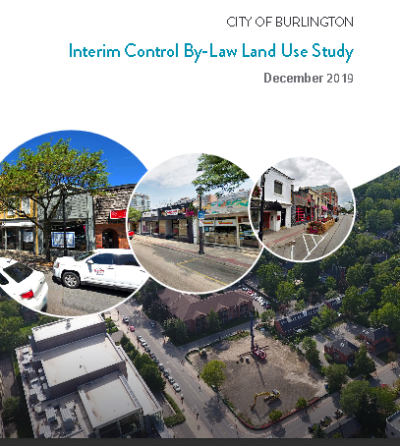 135 pages long and dense + the appendices. The Mayor has said she would be burrowing down and working her way through the several documents that were part of the Land Use Study that was brought about when the Interim Control Bylaw (ICBL) was passed last March. The document and its appendices are not for the faint of heart; it will be interesting to hear what Council has to say when it meets at a Statutory Meeting January 14th.
Those who do read the document might well ask if the will of council has been fully discerned by the consultants who wrote the report and the Planning staff team that sent the report to Council.
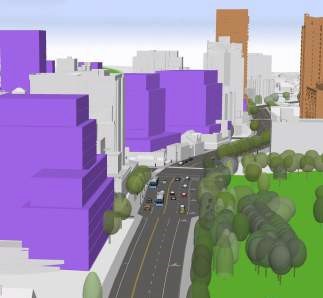 The Taking a Closer Look at Downtown report was a blurred image to many. They get another chance on January 16th to put up a clearer picture. Two days after the Land Use Study Statutory meeting council will see the second version of what might be included in the Re-examination of the Adopted Official Plan report that didn’t get a round of applause from Council when they reported to Council in December.
At the risk of appearing petty we wonder just how many members of Council reported the gifts they received from developers, National Homes appears to be the one looking for “por favour” from Council – they have two applications that are both at LPAT with settlements that have yet to be given the LPAT seal of Approval.
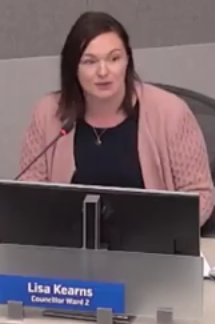 Kearns chose to share the gift she got with her colleagues. Several of the Council members said that they didn’t accept the gift – instead passed it along to a community organization – except for Councillor Kearns who, after explaining in some detail that she does not accept gifts, went on to say that she shared the gift with others on the 7th floor – which is where we house Council members.
Roland Tanner, who actually reads critical documents that come out of city hall, pointed out that the Code of Good Governance , a document signed by every member of Council, as well as being the subject of a half day Workshop, states quite clearly what is to be done with any gift that gets sent along to a Council member.
One of the requirements is to report receipt of the gift to the Clerk, who is required to report annually to the public on who was offered what. We will watch for that report.
The October 2018 municipal election gave the city a new set of wheels to move forward on; the electors chose the candidate for Mayor they believed could best bring about the change they wanted. There was no doubt about that vote.
The five newcomers have had the time they needed to get to know and understand each other; appreciate the different strengths and weaknesses and create some common cause.
In the first six months of 2020 they are going to have to make some very significant decisions – the response to the Land Use Study, getting a rejigged Official Plan in place and sending a stronger message to Staff on just what the will of council is and making sure they understand just what that will is and that it is adhered to – we aren’t there yet. Several news stories and opinion pieces we will publish in the days ahead make that point quite clear.
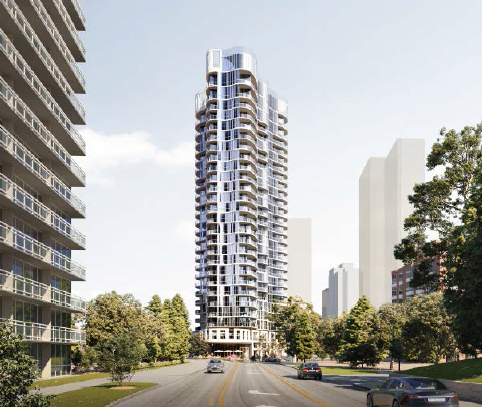 Proposed for the eastern gateway to the downtown core. The city and its bureaucrats need to make it as clear as possible to the development community that Burlington is not a community where anything goes.
 Mayor Marianne Meed Ward: Much more than a pretty face. Mayor Meed Ward has shown that she knows how to take the gloves off and land a solid punch on the nose – when the Grow Bold mantra had lost favour and whatever charm it had, the planners were a little slow in getting the message. Meed Ward made the course correction that was necessary when she said: would “provide absolute clarity to staff and to the community that the City of Burlington staff are not to use the adopted 2018 plan in evaluating current/new development applications. Multiple analyses by staff in assessing development applications, downtown in particular, have made it clear we do not need to over intensify in order to meet our obligations under the Places To Grow legislation.”
 It is going to be an interesting six months – far too early to suggest that the year will be: a great one for the city – although the potential is certainly there. It is going to be an interesting six months – far too early to suggest that the year will be: a great one for the city – although the potential is certainly there.
That phrase on the city crest Stand By is perhaps the appropriate phrase for the year.
And lastly – do the police have Sean Baird in custody ? And if not – why not?
Salt with Pepper is the musings, reflections and opinions of the publisher of the Burlington Gazette, an online newspaper that was formed in 2010 and is a member of the National Newsmedia Council.
Related news stories:
Mayor shows how to get a message to Staff
The gifts that shouldn’t have been accepted.
Come home Sean.

 By Ray Rivers By Ray Rivers
December 31, 2019
BURLINGTON, ON
What if my new year resolution was to stop writing about global warming?
I realize that I have been preoccupied, some might say obsessed, by what I see as the greatest existential threat facing the planet and all of its inhabitants. And there is a kind of frustration that, after spending decades working on climate change policy with governments and the private sector, so little has actually been accomplished.
 Coal fired electricity generators. Brian Mulroney and Bill Clinton first talked about carbon pricing back some 30 years ago. Jean Charest, my minister of the environment, spoke of the urgency of global warming at the Rio climate summit back in 1992. Jean Chretien took us in the Kyoto protocol and McGuinty and Wynne got us off coal fired electricity.
Yet today Donald Trump is the world’s biggest advocate for dumping more carbon emissions into the atmosphere. And despite some progress on the climate file since Stephen Harper’s government was voted out of office, something as straight forward as Canada’s carbon tax is still being debated in the courts.
Today, over 90% of all new cars are still powered by petroleum and new houses are still being built with gas appliances and fixtures. The Alberta and Saskatchewan governments, with their populations solidly behind them, are promoting even more oil and natural gas development and export.
And even Ontario’s progressive development of green energy has been stopped in its tracks by a new government determined to unravel every single piece of environmental legislation developed by all three political parties dating back as far back as the 1980’s.
Yet the evidence, the signs, of what we are doing to the planet is overwhelming. The latest sign comes to us from satellite imagery of a massive patch of superheated water the size of Texas, threatening oceanic life just off the coast of New Zealand. This year flooding and storm intensity continued to expand across the globe – leaving an ever increasing path of destruction.
Wildfires in Canada now destroy 2.5 million hectares a year, an area nearly half the size of Nova Scotia and double the 1970s average. Alberta is one of the worst affected areas. Of course as the highest polluting jurisdiction in Canada, it is as if some invisible hand is administering retributive justice.
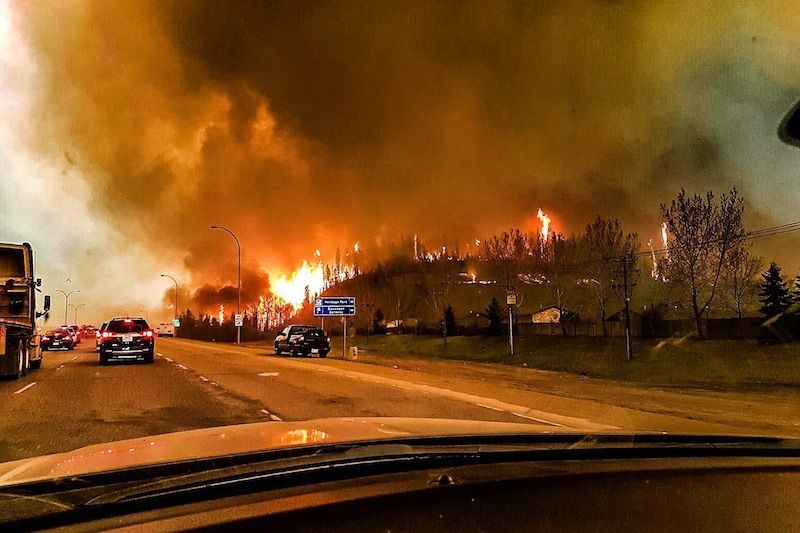 Forest fires raging through Fort McMurray Alberta The Fort McMurray fire in 2016, smack dab in the heart of the oil sands, was the largest wildfire evacuation in our history. And Australia is a stark reminder of where we are heading. I received a Christmas card from a friend in Melbourne Australia. She wrote “The fires are a real tragedy and a reminder that we should be doing more to stop climate change.”
Indeed, Australia is by far the world’s largest coal exporting nation. That would be a good place to start.
Andrew Scheer and other climate change deniers have pointed out that Canada’s national emissions are only a fraction of those of China and the USA. For them it was a matter of ‘After You, Alphonse’ as per the old New York Journal comic strip. They conveniently ignore the fact that Canada will experience twice as much warming as these other nations – so it should matter more to us.
 Arctic sea – vital to the environment. And the other thing they don’t tell you is that oil, coal and gas exports are not included in our emission numbers. So in 2014 we emitted more carbon embedded in our fossil fuel exports than we emitted nationally. We effectively doubled our contribution to global warming. But it is worse that that. By adding more coal, oil and gas onto global markets we help lower the prices of these commodities.
It’s simple demand and supply. Lower fossil fuel prices promote more consumption and carbon emissions, making a sad mockery of Messrs Scheer, Moe and Kenney’s perverse claims that they can combat climate change by simply exporting more fossil fuels. When he heard that kind of nonsense spoken in public, my father used to say, “they need their heads examined”. But these are political leaders at the highest levels so it has to be more than just deceptively flawed logic.
Energy use, including transportation and home heating, is still one of the biggest aspects of our carbon footprint. Lower fuel prices will forestall decisions to substitute cleaner energy for the internal combustion engine and that gas flame for your heating and cooking needs. Higher prices encourage conservation – that is why the carbon tax will be effective.
 The hope is the words spoken by Greta Thurnberg, a 16 year-old Scandinavian A new year should bring us a moment for hope and promise. There is always hope but the promise for our future is not pretty. My annual predictions in the past have been erratic, sporadic and often just plain wrong. So this year I thought I’d just go with the collective global science community.
Their prediction is that we are moving faster than ever towards a tipping point. And if they are right, in about a dozen years global warming will become irreversible and get worse every year thereafter.
As we struggle with the effects of the proverbial hangover January 1st, we should contemplate what lies ahead for us in what seems to be a highly dystopian future. The fact is that our governments have failed to protect us. Or perhaps, and more accurately, we have mostly failed to elect the kind of governments which would have acted sooner and more effectively.
So I’m taking action in my own hands this year and suggest you join me. I’m making and planning to keep resolutions to lower my individual carbon footprint. I already have geothermal heating and cooling, an electric plug-in car and a solar panel. So this year I’m resolving to get rid of my remaining gas appliances entirely, including my fireplace and barbecue.
What about you?
 Ray Rivers writes weekly on both federal and provincial politics, applying his more than 25 years as a federal bureaucrat to his thinking. Rivers was a candidate for provincial office in Burlington where he ran against Cam Jackson in 1995, the year Mike Harris and the Common Sense Revolution swept the province. He developed the current policy process for the Ontario Liberal Party. Ray Rivers writes weekly on both federal and provincial politics, applying his more than 25 years as a federal bureaucrat to his thinking. Rivers was a candidate for provincial office in Burlington where he ran against Cam Jackson in 1995, the year Mike Harris and the Common Sense Revolution swept the province. He developed the current policy process for the Ontario Liberal Party.
Background links:
The Future – 2019 Predictions – 2020 Predictions – Australian Reality –
Hot Water – EVs – Oil Subsidy – We Didn’t Get Much Done
Cost of Climate Change – Exporting Carbon –

 By Pepper Parr By Pepper Parr
December 20th, 2019
BURLINGTON, ON
More than eight years ago during a conversation with then Mayor Rick Goldring he remarked on how surprised he was when people would approach him in the supermarket or at some event and chat him up. It wasn’t something he expected when he was elected Mayor.
 There were different views on Rick Golding’s effectiveness as a Mayor – but there was never any doubt that he cared passionately about his city. See him in a Santa Claus parade collecting loonies and twonies in a sock. But it is what people expected of their elected representatives. In Burlington people want to keep that small town feel and know that they can approach their member of city council to talk about a problem or a concern. The practice then, for many of the council members, was to give the citizen their business cards and ask them to call their assistant, explain the problem and the Councillor would follow up and make sure it was taken care of.
Then something changed. Not sure where the change came from. We recall conversations a number of years ago from a General Manager (when Burlington had General Managers) about installing a CSR (Customer Service Response) system – this was supposed to handle all the communications problems.
The Gazette is in touch with members of Council frequently – the level of response varies, most get back quite quickly. There is one who said he had been told “not to talk to you” when we approached and asked a question.
We recently sent a note to a member of Council and used the new system – the one where you enter the ward number – ward4@burlington.ca – if you wanted to reach Shawna Stolte.
Here is what came back to us:
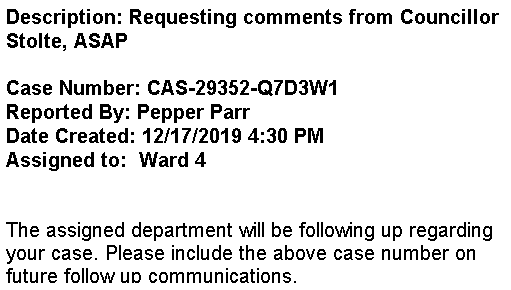
Being referred to as a “case number” didn’t strike me as all that customer friendly.
Maybe times are changing and it will all come down to each of us being a “case” with a number from which all our questions will be answered.
How much did the city spend on the system that assigns me my case number and are we getting value for those dollars?
Perhaps the problem is the Councillors just don’t have the time needed to respond to all the calls.
There is a solution to that problem – add more Councillors. But that is not likely to happen for one reason – it would impact on the financial interests of the current members of Council.
Burlington has seven seats on the Regional government Council. If we added Council member they would not get a seat at the Regional level and not earn the $50,000 +/-
Oakville solved that problem by having members of Council that are Regional Councillors as well as town Councillors and some who are just town Councillors.
 There are seven members of council in Burlington – are they able to meet the needs of the people they represent? It is a direction Burlington should at least be looking at – soon, so they can be in a position to approach the electors in the 2022 municipal election with a council structure that meets the needs of the citizens.
Don’t expect the current council to put that kind of initiative on the table.
Salt with Pepper is the musings, reflections and opinions of the publisher of the Burlington Gazette, an online newspaper that was formed in 2010 and is a member of the National Newsmedia Council.

 By Ray Rivers By Ray Rivers
December 19th, 2019
BURLINGTON, ON
“President Donald Trump, Florida Gov. Rick Scott, Florida Sen. Marco Rubio, and others who oppose action to address human-induced climate change should be held accountable for climate crimes against humanity.” (Jeffrey David Sachs- special adviser to the UN)
 He had no idea what he was doing to his body. Have we learned anything from the tobacco companies? For decades they understood the consequences of smoking and second hand smoke. But rather than changing their product, or at a minimum, informing the public, they lied – hiding the truth about the dangers, sowing confusion and misleading the public about the health hazard of their products. It was deliberate and it was manslaughter – a crime against humanity.
So now we find out that the oil companies did the same thing. Their research as far back as the fifties pointed to today’s evolving climate change. And they too established a program of disinformation and outright lies, enabling climate deniers like GW Bush and Stephen Harper to employ the uncertainty they created as an excuse to resist climate action.
 Greta Thunberg Alberta’s latest enabler Jason Kenney has just opened his energy war room, furthering the notion that Alberta is under attack by the environmentalists. And he’s poured $30 million to make himself battle ready for the fight to the finish against the 16 year young Greta Thunberg and those other fearsome greenies. And the chest pounding, hype and propaganda are working.
Albertans were motivated to donate more than anyone else in the last federal election, hoping to get the pro-oil Conservatives elected. And now Kenney’s blind defence of big oil has even spilled over into the classroom. Parents at one Alberta school have threatened a teacher not to use a balanced approach, pros and cons, when it comes to teaching about the oil sands. According to the oil zealots there can be no discussion of a downside to Alberta’s biggest industry.
A few days ago Mr. Kenney rode into Ottawa to shake hands with Mr. Trudeau and pretend he wanted to mend fences, offering him one heck of a Faustian bargain. Green light another monster oil sands project and reap some kind of political peace in exchange. It was an offer he thought Trudeau couldn’t refuse. But chances are pretty good he will.
The Teck Resources proposed Frontier mine oil sands project would convert 24,000 hectares of mostly northern Alberta wetland into two massive open mine pits, a bitumen processing plant and a tailing pond for the toxic waste residue. And it would likely need another pipeline to move the estimated 260,000 barrels of bitumen a day the project will produce.
Four million tonnes of greenhouse gases (GHG) a year will be pumped into the atmosphere every year for the next 41 years. The project would last over a decade beyond the PM’s commitment to achieve net zero emissions. And that does not account for the GHG emissions resulting from burning all that oil.
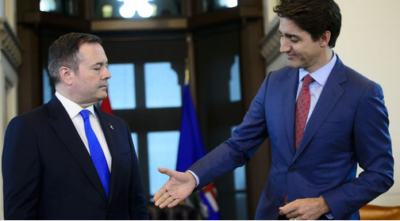 Kenney did eventually shake the Prime Ministers hand. And is Kenney serious? How would Trudeau square approving this massive carbon emitting project with his 2030 emissions target. He would lose any credibility he has on the climate change file and with it the support of the third parties, whose support he is counting on for this current mandate. Mr. Kenney may not be the devil but he came to Ottawa to steal Justin’s soul and then to damn the rest of us to an ever faster and more aggressive global warming.
Look at Australia which has just experienced its hottest day ever amid the worst bush fires in the nation’s history. The massive area of scorched earth will take decades before it can be rehabilitated, its wine industry has been dealt a blow and a toxic cloud has blanketed its largest city and drifted across the Tasman Sea as far as New Zealand. The fires have emitted half of the annual GHG national contribution of carbon, and they are still burning.
Australia is the world’s largest exporter of coal, mainly to Asia. Much like Canada it has an obscene carbon footprint, not even counting the emissions from the coal it exports. It once dabbled with a carbon tax, but like we did in Ontario the Aussies booted out their environmentally conscious government for one led by a series of right wing climate action deniers.
And speaking of Ontario, premier Doug Ford is as busy as ever eliminating every single climate change mitigation program the previous government had initiated – as if somehow the climate is a partisan issue. And the provincial auditor general has warned that Ford will not come anywhere near the provincial 2030 emission reduction target. But nobody, including his environment minister, expects him to, anyway.
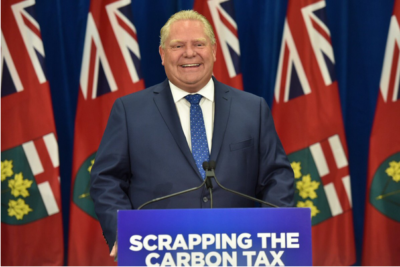 He means every word in the sign before him – unfortunately. So far he has cancelled the provincial cap and trade carbon pricing system, eliminated rebates for home energy conservation and electric vehicle (EV) purchases, cancelled plans for high speed rail travel, ended the provincial EV charging station program and the requirement for charging to be available in new housing. He has shut down almost 800 renewable energy projects, is fighting the federal carbon tax up to the Supreme Court, and has just canceled Hamilton’s light rail transit system.
Transitioning to a zero carbon society is unlikely to be accomplished at zero cost. But as we have already seen, the consequences of climate change will be much more costly. Just ask the Australians. And the fact is that the cost for many of the transitional changes can be phased in as existing infrastructure gets replaced. Or the costs can be redistributed and shared, like the carbon tax, to avoid major impacts for those in need.
Pennywise and pound foolish are those who would avoid transitioning as quickly as possible to a lower carbon footprint. Financial debt can be paid off, but restoring the earth’s climate and the life it supports, once we have passed a tipping point will be impossible. Which do we think future generations would object to the most? And who do you think they will blame for these climate crimes against humanity?
 Ray Rivers writes weekly on both federal and provincial politics, applying his more than 25 years as a federal bureaucrat to his thinking. Rivers was a candidate for provincial office in Burlington where he ran against Cam Jackson in 1995, the year Mike Harris and the Common Sense Revolution swept the province. He developed the current policy process for the Ontario Liberal Party. Ray Rivers writes weekly on both federal and provincial politics, applying his more than 25 years as a federal bureaucrat to his thinking. Rivers was a candidate for provincial office in Burlington where he ran against Cam Jackson in 1995, the year Mike Harris and the Common Sense Revolution swept the province. He developed the current policy process for the Ontario Liberal Party.
Background links:
Crimes Against Humanity – Tobacco Crimes – COP 25 Madrid –
Australia – Alberta Political Donations – Teacher Threatened –
Kenney – Natural Gas – Oil Sands – Alberta War Room –
Oil Deception – More Australia – Hamilton –

 By Ray Rivers By Ray Rivers
December 13th, 2019
BURLINGTON, ON
Readers will know that it is not often I agree with Andrew Scheer. But I was encouraged by the part of his rebuttal to the throne speech, where he raised resolution of the year-long China problem. And again, I applauded Scheer’s follow-up motion to strike a committee to that end, a motion supported by all the opposition parties, though not the Liberals.
 Scheer’s motion to strike a committee that would look into Canada China relations was a good move. It’s possible the government knows what it is doing on this file and has it under control. But that’s not good enough. Canadians are in the dark and want some answers. The Chinese leadership’s anger over the detention of the nation’s Huawei executive is unmeasured and precipitous. Seizing innocent Canadians and torturing them to make a point and then declaring a trade war are pretty hostile acts for a nation which used to consider Canada one of its best friends in the west.
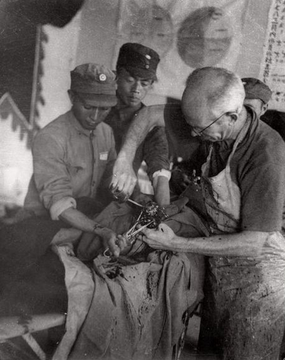 Dr. Norman Bethune saved the lives of millions of Chinese soldiers and civilians during the second Sino-Japanese war. He is credited with bringing modern medicine to rural China. Canadians were once held in high regard. Our own Dr. Norman Bethune saved the lives of millions of Chinese soldiers and civilians during the second Sino-Japanese war. He is credited with bringing modern medicine to rural China, having treated sick villagers as well as wounded soldiers. His selfless commitment made such an impression that Mao Zedong wrote a eulogy to him on his death – one that had been celebrated by generations of Chinese people.
That may be too long ago for today’s Chinese leaders, but even they might have heard that it was Justin’s father, Pierre, who made Canada the first western country, since before the Korean War, to it grant it recognition as the rightful government of China. Canada also played the lead role in bringing China into the World Trade Organization, something which stinks of irony now that we are having to sue them over their illegal blockade of our oil seed and meat exports.
China is our second biggest trading partner. But the trade is horribly lopsided. We import much more than they buy from us. In 2016 we imported over $40 billion more than we exported to China. Much of that trade is in the kind of disposal-ready stuff one sees at the Dollar Store or Walmart, aka China Inc. Chinese-made goods have virtually helped decimate our textile, book making and other manufacturing industries.
And Canadians are starting to get fed up. For example, a recent Pew Research survey showed that two-thirds of Canadians now view China negatively. But we don’t see that reflected in the limited actions our federal government has taken so far, actions which have failed to bring about the kind of behavioural changes we should expect.
So people are speaking up. The Senate recently suggested using the Magnitsky law to sanction Chinese officials. Somebody else has mused that we should ban commercial air freighters from over flying Canada. Of course banning Huawei from investing in Canadian telecom infrastructure, as most of our five eyes partners have done, is a no brainer.
 Emerald ash borer: The insect arrived from China in some kind of wood product and is now eradicating ash trees across this province. Even though China is in the WTO, the nation is anything but a fair trader, it has a long history of ‘dumping’ goods on foreign markets, stealing intellectual property and manipulating its currency. We could retaliate in kind. For example banning all Chinese forest products as a precaution against something like the emerald ash borer ever happening again. The insect arrived from China in some kind of wood product and is now eradicating ash trees across this province.
The Trudeau government has promised legislation to ban single use plastics. We could virtually ban imports from all nations, including China, which are packaged in plastic – or at least insist that all exporting nations take its waste back for recycling… and not just dump it in the ocean.
And then there is the question of foreign investment. Mr. Trudeau, like his processor Mr. Harper has appeared indecisive and inconsistent, seemingly making up policy on the fly, when trying to decide just how much of our door we can safely open to the second largest economy on earth.
Today’s China is a rapidly militarizing autocratic state with a president-for-life. And given the upshot from this Huawei extradition morass it is clear that China understands neither the rule of law nor how to conduct non-combative diplomacy. One just needs to consider Tibet, Tiananmen Square, Falun Gong, Uighurs and now Hong Kong where 300,000 people with Canadian citizenship live.
 Tiananmen Square and the courage of one man – changed the world. This is a complicated and even dangerous file, and lives are at stake. In addition, China has been touted as one of the potential markets for all that extra oil and gas which Alberta and B.C. keep saying they can export. But how likely is that if Canada responds in-kind and the spat escalates?
Andrew Scheer did the PM a favour by striking this committee, something which Trudeau may learn to appreciate, despite his knee jerk rejection. Perhaps he is concerned about control. Though chaired by the PM’s party, Liberals are not in majority. And the PM and ministers can be called to testify as witnesses. And why not? Call it full disclosure. Call it burden sharing. Call it how minority government should work – that is, cooperatively.
It is been a rare moment when this columnist actually agreed with the leader of the Conservative party. And then Mr. Scheer has the gumption to up and resign, apparently because he was under attack for using party funds to send his kids to private school. Maybe I shouldn’t have been so quick to give Scheer my blessing.
 Ray Rivers writes regularly on both federal and provincial politics, applying his more than 25 years as a federal bureaucrat to his thinking. Rivers was once a candidate for provincial office in Burlington. He was the founder of the Burlington citizen committee on sustainability at a time when climate warming was a hotly debated subject. Ray has a post graduate degree in economics that he earned at the University of Ottawa. Tweet @rayzrivers Ray Rivers writes regularly on both federal and provincial politics, applying his more than 25 years as a federal bureaucrat to his thinking. Rivers was once a candidate for provincial office in Burlington. He was the founder of the Burlington citizen committee on sustainability at a time when climate warming was a hotly debated subject. Ray has a post graduate degree in economics that he earned at the University of Ottawa. Tweet @rayzrivers
Background links:
Trudeau Legacy China – China History –
Throne Speech – Magnitsky –

 By Pepper Parr By Pepper Parr
December 11th, 2019
BURLINGTON, ON
With the budget before them and the Mayor having whittled down what she would like to see in the way of a tax increase to 3.99% it was time for delegations to speak about what they would like to see.
There were several outstanding delegations – asking for the most part for additional staff to be on the Climate Change file and for better communications coming out of city hall.
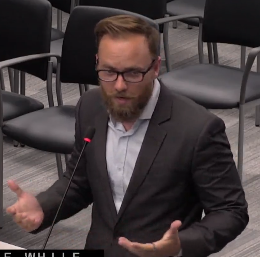 Myles Rusak, Executive Director Sound of Music Festival: Making his case for a funding increase. There were two exceptions: Myles Rusak speaking for Sound of Music who wants an additional $40,000 a year each year for the next three years starting with this year.
Why?
The other levels of government have cut back on what the Sound of Music was getting and SoM isn’t interested in cutting back. They want the city to make up the short fall.
Their view seems to be that if they cut back on the quality of what they have been doing, audiences will dwindle and the economic impact of what SoM does for the city will dwindle as well.
Last year SoM did a two day kick off – that’s the period of time when paid ticket performances are put on stage – to raise money for the shows that the public can see free.
The two day Kick off didn’t work out all that well last year – so it will be just a one day event going forward.
It may be quite a bit less than that if the city doesn’t come up with some cash.
There is a Municipal Accommodation Tax somewhere in the works at Queens Park – Myles wants to get a piece of that using the phrase “100% – we want some of those dollars”. Mayor Marianne Meed Ward pointed out that it is city council that decides where the dollars go. Municipal Accommodation Tax (MAT) Hotels and people doing short-term rentals must pay a four per cent Municipal Accommodation Tax (MAT). More information will become available in December 2019, regarding short-term rental regulations.
Myles told Council, meeting as a budget committee, that SoM has been meeting with anyone that delivered a service to the public, looking for ways to partner with them. The YMCA, the Library, the Museum, the Performing Arts Centre – conversations have taken place looking for ways to partner with them.
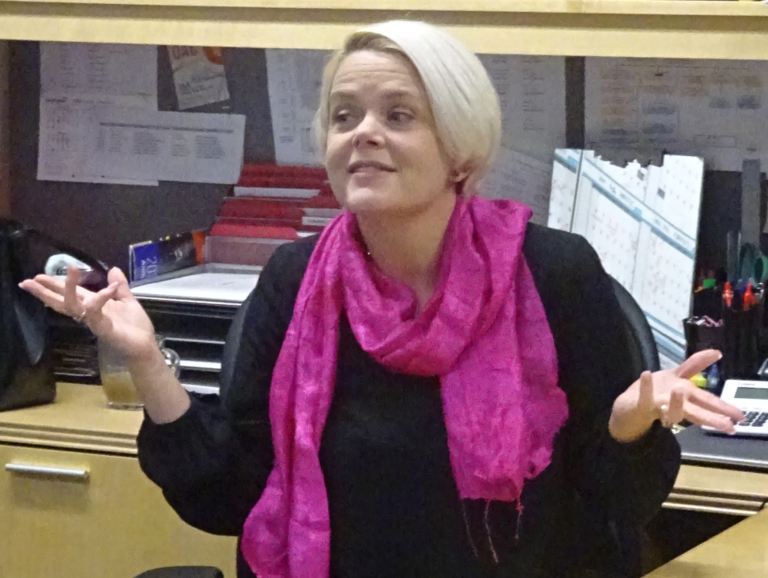 Tammy Fox, Executive Director of the Performing Arts Centre has been waiting to hear from Myles Rusak for sometime. Roll that film back – during our last interview-conversation with Tammy Fox at the Performing Arts Centre she said that she has been trying for a couple of years to put something together with the SoM. Which is correct? We’re going with Tammy.
Myles told council that he has as yet not been able to meet one-on-one with every council member. Then he hasn’t been trying very hard. Councillor Sharman would certainly like to have a conversation with Myles and the SoM music long term plans – the Mayor probably has some sage advice for Myles as well.
Myles talked the big picture and said that that the Sound of Musical Festival was going to drop the word Festival from the brand name.
The want to be seen as more than a ten-day event and become the organization that gives the music industry in Burlington the cohesiveness it lacks.
Myles wants SoM to be the curator of everything that is music in town – from what takes place at the Library to what is featured at Emmas.
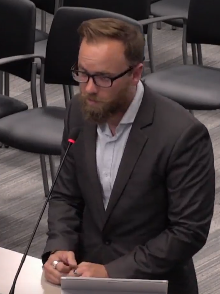 The Sound of Music wants to morph from a 10 day event to become the curator of everything musical in the city. They are looking for much more in the way of clout. It is an ambitious reach – one that is going to have to be earned and not taken.
SoM was once an organization that had an active membership – anyone could be a member and every member could vote for the Board of Directors. That form of governance disappeared about four years ago when Andy Porecki was Executive Director.
When the Board decided that Dave Miller needed to use the exit door – he was dismissed rather unceremoniously which threw the membership into a serious state of confusion. SoM almost had a mutiny on its hands. The unhappy members were not able to organize themselves and bring about changes that would make the organization more transparent and accountable.
Councillor Sharman wanted to know what part the city would play in this change in the way music would be managed, overseen and developed. “We have people on staff” said Sharman who can and should be part of the thinking you are doing.”
Myles said he has had meetings with a few people at Parks and Recreation and he has been working with Tourism as well.
The SoM gets $106,093 from the city each year. He wanted that bumped up by $40K this year and an additional $40,000 for the next two years.
Myles said they are putting together a television show with Cogeco and that there are plans to put on a program with the Indigenous community that will be highlighted in 2020.
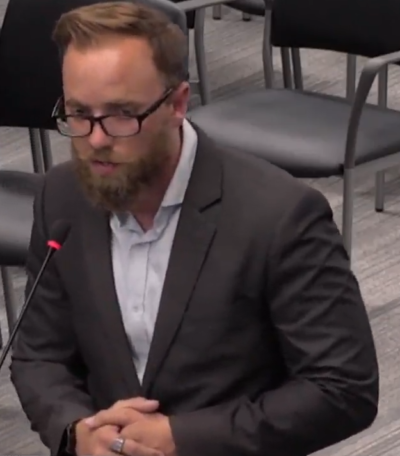 Sound of Music needs a fatter cheque from the city. Sharman wanted to know a lot more before he went anywhere with additional financing. As he put it he “wants to eat the meal before he pays for it”.
Councillor Kearns cut Myles short – as chair she had heard enough. Kearns sits on the SoM Board.
Myles Rusak should wait for a fatter cheque to arrive from the city. He should take Tammy Fox out to lunch – she really does want to do some business with the Sound of Music people – she has been trying to get something going for more than two years.
Myles needs to learn just who will butter the bread he needs. Council needs to be romanced.
Related news stories:
SoM lets council know they will be back looking for financial support
SoM volunteers feel left out.
S0M – trouble in paradise
Salt with Pepper is the musings, reflections and opinions of the publisher of the Burlington Gazette, an online newspaper that was formed in 2010 and is a member of the National Newsmedia Council.

 By James Young By James Young
December 9th, 2019
BURLINGTON, ON
I attended The Planning and Development Committee on Thursday when Councillor Bentivegna expressed his controversial “disappointment” with a delegation.
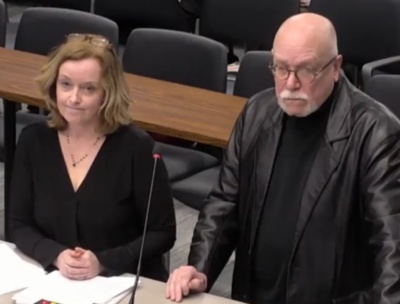 Lynn Crosby and Blair Smith delegating at city hall. I heard presentations by city planners and consultants, one doesn’t have to agree with them to find them informative. I heard informative delegations from Lynn Crosby and Blair Smith of “We Love Burlington” and Don Fletcher for “Plan B”, the conscience of our waterfront. I heard self-serving delegations from developers and their professional associations, leaving me wondering: Do developers from Hamilton or Toronto deserve equal consideration with local residents who have to live with the developments long after developers have moved on?
In the evening session I heard a detailed delegation from Gary Scobie, who provided councillors with a concise, accurate and informative planning history of Downtown. I hope council and staff learn as much as I do every time Gary delegates.
Roland Tanner, for Engaged Citizens of Burlington, gave an intelligent dissertation on the compromise inherent in the staff recommendation, to get the Official Plan done now and fight the Major Transit Station Area (MTSA) and Urban Growth Centre (UGC) designations later.
I loved David Barker’s idea of a pedestrian area at Lakeshore and Brant St.
Coming from Glasgow where, in the 1970s, Sauchiehall and Buchanan Streets were pedestrianised and closed to traffic. On a Burlington scale: this is the equivalent of closing Lakeshore from Guelph Line to Maple Ave. and Brant Street from Fairview to Lakeshore. Despite the hue and cry at the time about where will cars go? How will local businesses survive?
Fifty years on, these streets bustle with successful retail, patio cafes and restaurants, buskers on street corners, making it one of the most vibrant and attractive pedestrian precincts in the world. So closing Brant from Caroline to Lakeshore as a pedestrian precinct seems easily achievable if the city will is there.
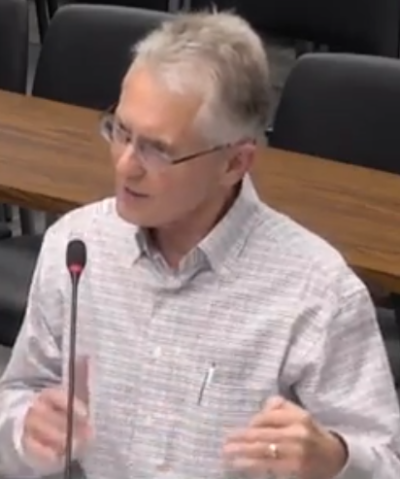 Gary Scobie during his delegation. Then there was the “disappointment” that councillor Bentivegna expressed at some of Gary Scobie’s delegation. This seems to have outraged some Gazette contributors.
I disagreed with the councillor. Gary was spot on in his summation of the Downtown OP Review. But was it outrageous or disrespectful? Have we reached a stage in our sensitivity that any criticism or response to a delegation is somehow offensive? What I saw was a poorly thought out point from the councillor, very ably responded to by Gary in what he later described as the normal thrust and parry of council/delegate debate.
My take on outrage is: “Commentators may not be more outraged than the victims.” I happened to be sitting with Gary and Roland Tanner when Clr. Bentivegna stopped by to discuss their delegations. Neither Roland nor Gary were outraged or offended. For those so outraged by a single word, cast your minds back to a time when five of seven councillors repeatedly offended and were downright rude to delegates like Gary, Tom Muir, Lynn Crosby, myself and many others. While I understand and respect Clr. Nisan’s desire for decorum, perhaps he was a little quick on the draw in this case.
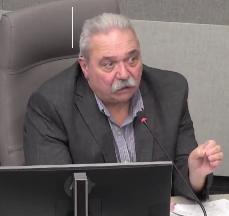 Angelo Bentivegna I was actually more offended when Clr. Bentivegna appeared to question the legitimacy of Roland Tanner’s ECoB delegation, while he accepted the presence of We Love Burlington and Plan B groups without question. Perhaps he should reflect on the influence of ECoB on the outcomes of last municipal election and be quietly thankful.
I leave readers with two thoughts on the Downtown Proposals:
If an OP is approved based on the existing designation of downtown as a MTSA/UGC, then those designations are rescinded, doesn’t that nullify that OP?
Might developers appeal that at LPAT?
Might the Province or Region resist undoing those designations on the grounds that the new OP was approved based on those designations?
I also worry that the planner’s two options are based on provincially mandated “average” UGC density targets of around 200 people or jobs per hectare. Yet developers will still apply for amendments on a case by case basis, most of which considerably exceed that number.
Judging by past appeals it appears that LPAT adjudicates on this case by case basis, regardless of Official Plan’s average densities. This will inevitably lead to over intensification which will strain infrastructure, roads, transit, traffic congestion, all of which are planned around that 200 average.
 James Young is an Aldershot resident who has delegated at city hall frequently. James Young is an Aldershot resident who has delegated at city hall frequently.

 By Joseph A. Gaetan By Joseph A. Gaetan
December 9th, 2019
BURLINGTON, ON
At the moment, the secondary school unions and the Ontario government are at loggerheads over whether 4, 2 or 0 online classes should be offered. Having experienced both traditional and e-learning firsthand I can attest to the fact that in both cases some courses are delivered better than others.
 Take your courses when you want – where you want and if you didn’t get it the first time yo can replay the class. In my experience there is room for improvement on both fronts and not every subject is a candidate for e-learning. One of the criticisms I have heard about e-learning involves access to tutors, something I found to be both a problem and an opportunity. On one hand not having instant access to a tutor can be frustrating, on the other hand, from personal experience, it can make you dig deeper for the solution. In education, as in life, some of the things that stick with us the most are the things we had to work the hardest to achieve. Easy and instant access to resources is not always the answer and is not always the best form of education.
Say or think what you want about online learning, it has been here a while and it is here to stay, and, it’s growing in leaps and bounds. For many people it is a game changer as it may be the only way they can earn those last few credits or a credential that they otherwise would not be able to earn. For some it is a matter of cost or a way to balance raising a family while earning a living.
According to the “Ontario Learn” website, in 1995 seven colleges put their heads together and started to offer online courses, today 24 Ontario colleges offer high quality online education. The original seven realized that by pooling resources, they could extend their reach by offering online courses and programs to students who would not otherwise have access to them.
“Athabasca University” (AU) is a Canadian Open University specializing in online distance education and is one of four comprehensive academic and research universities in Alberta. Founded in 1970, it was the first Canadian university to specialize in distance education. Athabasca offers online undergraduate and graduate programs and courses. AU serves over 38,000 students (over 7,900 full-load equivalents) and offers over 900 courses in more than 50 undergraduate and graduate programs in a range of arts, science and professional disciplines.
If you haven’t heard of a MOOC, you aren’t alone. MOOCS or Massive Open Online Courses have unlimited participation and open access via the web. EDx is just one online MOOC platform that has about 14 million learners and is the second largest MOOC provider in the world. The global MOOC market size was estimated to be $4 billion in 2018.
When I wanted to brush up on my knowledge of social media marketing, I turned to EDx and promptly found 10 offerings. One course from Boston University not only met my needs but allowed me, should I so desire, to earn a credit towards a Micro Masters. The course starts in April of 2020 and currently has 69,871 registrants.
So why all the fuss and push back here in Ontario? Online learning is anything but new. Online learning may also be the only choice for some people who have different learning styles or disabilities. My granddaughter is in grade 10 so I sought her opinion on the topic. Her response; she prefers having a teacher in front of her. Good enough. Online learning is not for everyone. Some students like my granddaughter prefer a live teacher, some may learn better, as I did, with online learning.
The current generation of high school students are prodigious users of online technology. So why not offer them online learning as part of our high school curriculum? Failing to offer online learning in this day and age is a missed opportunity.
Athabasca University has been around since 1970 and Ontario Learn since 1995, and 2020 is just around the corner, so let’s get on with it, but do it right, and by that I mean involving the right stakeholders be it parents, students, teachers and the government in the process.
There is but one pool of taxpayer money, some of that pool is dedicated to education, some of that pool goes towards paying for infrastructure, some for books and supplies, some for school repairs and maintenance, and some to teachers and other staff.
 There are strengths and weaknesses to online education. It does cost the governments less. We have one of the best and most expensive education systems in the world. In order to continue to be the best we must find a way to make online learning part of that system and we can either lead the way, or we can sit back and suffer the consequence of lagging as did Research in Motion (RIM) aka Blackberry.
At the moment online education is geared to post-secondary learning. I see two pathways for primary and secondary student e-learning. One has the government and other stakeholders working hand in hand to figure out how to make e-learning part of Ontario’s education future.
The other path is market based where the government with the help of e-learning experts such as EDx create a series K to 12 courses that are optional for those who would benefit the most. In the end this approach will only work if there is value to members of the target market, “the student”.
 Joseph A. Gaetan has a BGS degree in applied studies, earned through studies at The University of Waterloo and Athabasca University. He also earned a Province of Ontario Engineering Technology Certificate through Fanshawe College, and for 8 years worked at earning a trade becoming a Journeyman Machinist. He also studied French at the Centre Linguistique du Collège de Jonquière and Italian at Mohawk College. In addition, he has taken online courses through the EDx platform taking courses from Harvard, The University of Queensland, Wellesley and Delft Wageningen, he is currently working at learning 6 languages through Duolingo. His work career includes being a Machinist, a CNC programmer, a business owner, a consultant and the Director of Organizational Development for a Fortune 100 company. All of this thanks to life-long learning. Joseph A. Gaetan has a BGS degree in applied studies, earned through studies at The University of Waterloo and Athabasca University. He also earned a Province of Ontario Engineering Technology Certificate through Fanshawe College, and for 8 years worked at earning a trade becoming a Journeyman Machinist. He also studied French at the Centre Linguistique du Collège de Jonquière and Italian at Mohawk College. In addition, he has taken online courses through the EDx platform taking courses from Harvard, The University of Queensland, Wellesley and Delft Wageningen, he is currently working at learning 6 languages through Duolingo. His work career includes being a Machinist, a CNC programmer, a business owner, a consultant and the Director of Organizational Development for a Fortune 100 company. All of this thanks to life-long learning.

 By David Barker By David Barker
December 6th, 2019
BURLINGTON, ON
What is the Vision for the Downtown?
The public’s vision for the Downtown is to provide for a walkable, accessible, vibrant downtown which is similar to that set out in Section 8.1.1 of the Adopted Official Plan.
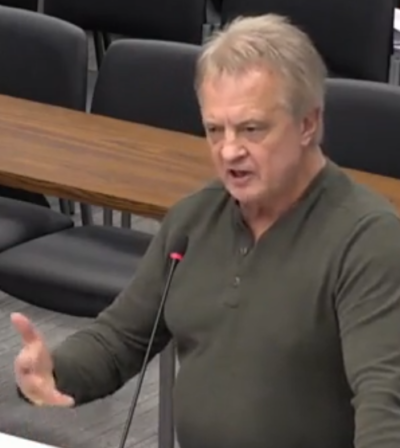 Lakeshore and Brant Main precincts should be both walk-able and accessible. However I question the concept the Lakeshore precinct is currently a pedestrian precinct, it is far from that status currently. However, the public’s vision also stresses the need to maintain and add new green spaces and trees, while providing additional space for year-round activities and festivals. The character of Brant Street as the ‘retail main street’ of Burlington with its eclectic mix of shops, meeting places and culture will be supported and enhanced. Lakeshore Road as the gateway to the waterfront will be maintained as an important pedestrian precinct to ensure the Downtown’s sense of place is preserved.
I noted the words “walkable”, “accessible” “additional space for year-round activities and festivals” are used.
I also noted the use of the following description “Lakeshore Road as the gateway to the waterfront will be maintained as an important pedestrian precinct to ensure the Downtown’s sense of place is preserved”.
Yes, the Lakeshore and Brant Main precincts should be both walkable and accessible. However I question the concept the Lakeshore precinct is currently a pedestrian precinct. It should be for sure. But it is far from that status currently.
I refer you to Page 36 of the consultant’s report where it states:-
Recently completed projects and those under construction such as Bridgewater and Saxony total an additional 335 units plus commercial and office space, which results in a further 2,068 persons and jobs. That’s a ratio of 6.17 people per unit.
Those projects that are approved but not yet built total an additional 732 units plus commercial space, which equals a further 1,225 people and jobs. That’s a ratio of 1.67 people per unit.
I don’t know why the ratios are so different.
Referring to the chart on Page 36 of the consultant’s report it shows for just the combined Lakeshore & Brant Main precincts between 1,350 units for concept 1 and 1,160 units for concept 2 should be anticipated.
At an average occupancy of 1.50 people per unit (my number) generates between 2,025 and 1,740 additional residents.
Then as per the same chart an additional jobs of between 495 and 610 for concepts 1 and 2 respectively will be created.
That’s a total of 2,520 and 2,350 additional people anticipated in the two precincts.
Those figures do not contemplate the increased congestion arising out of attracting people and traffic that the invigorated downtown will draw.
So my question is:-
How are we going to cope with all these additional people?
My intent tonight is not to pass judgement on Concept 1 or Concept 2.
To be honest whether it is decided to go for either of the two offered concepts, or another hybrid version, or another version altogether that results from the City being forced by outside forces to accept the tall buildings we are all fighting to prevent; we seem to be concentrating in isolation concerning ourselves as to what the “built form” will look like. How pretty will it be?
We do not seem to be giving what I believe should be simultaneous serious consideration as to how the City will deal with the issues that result from the reinvigoration of the downtown; issues such as traffic, parking, transit and other infrastructure.
These go hand in hand and must be developed simultaneously. Look at Toronto’s experience. It built and built and built, offices and condos and subdivisions, and totally ignored traffic, parking, transit and other infrastructure issues. All those items are now real headaches.
I have put forward to you all at a previous Planning and Development Committee meeting a suggestion that the City needs to be radical in its thoughts and approach to the future of the Downtown. These concepts offered by SGL are, in my view, just tinkering.
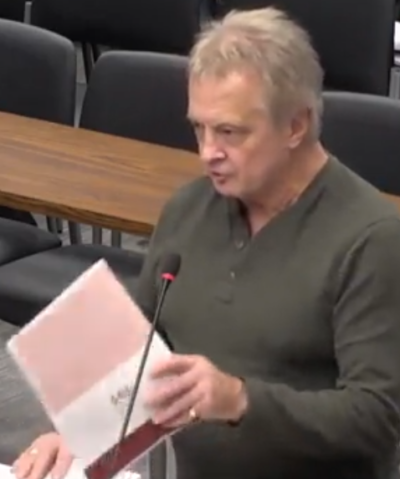 David Barker delegating before city council. Going off at a bit of a tangent, I would like to touch upon some things that have been said by earlier delegates. Mr Bales of Carriage House has as a part of his delegation submitted a letter to Council whinging and whining that the City has not provided his company with background research it has developed through this long study process. He infers the development community is being excluded from the City’s engagement process and so cannot support the City’s decision, whatever that might be. I find Mr Bales to be completely ingenuous.
He and his company have provided presentations on its proposed downtown high rise developments at Lakeshore and Pearl, and between Lakeshore and Old Lakeshore. These proposals completely ignore not only the in-force zoning bylaws but also the very clearly articulated wishes of residents not to have 20+ story buildings forming a canyon along either Lakeshore Rd. or Brant St. At those presentations he talks about bring benefits to Burlington through these high rises, but will never address the problems that will result.
A number of earlier delegates have expressed the position that residents do not want to see change in the downtown area. No one likes change. But change has to come. The downtown needs changing. It is only “ticking over” it is not “really revving it up”. I believe residents are only seeing a discussion taking place about the height of new buildings. There is no vision being offered as to what the downtown will look like. Give people a clear vision of how everything will look after the change and I believe buy in will come.
Which brings me to my previously suggested vision of the Downtown and Lakeshore precincts.
Let’s make the Downtown and Lakeshore Precincts totally pedestrianized.
That’s Lakeshore to Caroline and Martha to Locust.
Obviously certain vehicular access must be allowed for residents, businesses as well as transit.
The City should offer low cost bus transit between the downtown and Mapleview Mall, Burlington Centre, the Fairview & Appleby GO stations, where free parking would be available.
This will link Spencer Smith to Brant St, push transient commuter traffic back on to the QEW, where it becomes the Provinces problem (as it should be). It will reinvigorate the downtown.
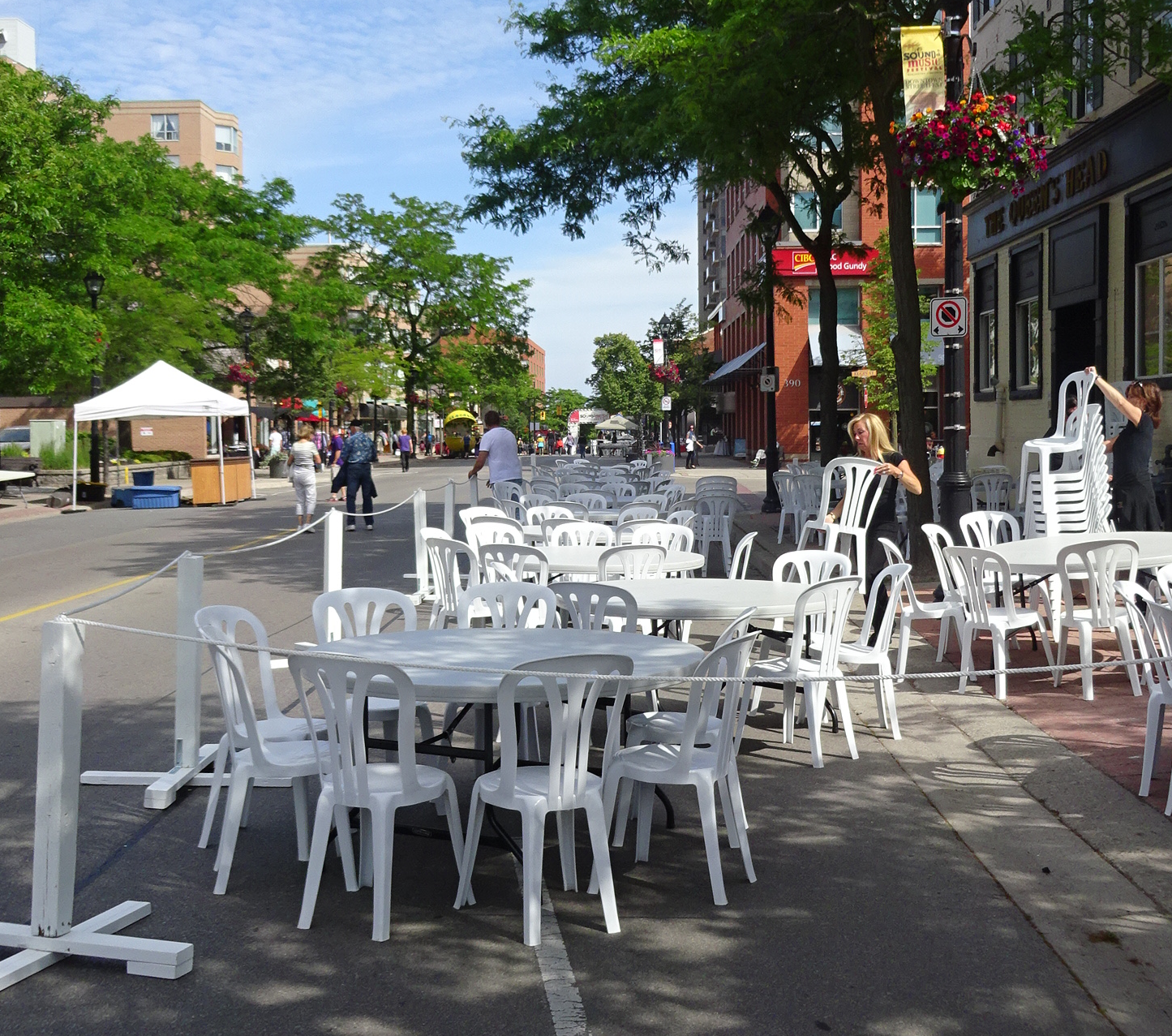 Brant street being set up for the Sound of Music – Barker would like to see it traffic free year round. Now I don’t wish to dwell on a sad event, but did anyone notice when watching news video of the knife attack that occurred in The Hague, Netherlands a week ago, that it happened right outside a Hudson Bay store, which is located in, yes you have guessed it, a pedestrian precinct.
I Googled “European Cities with pedestrian precincts” and got a list that included Vienna, Copenhagen, Prague, Zagreb, Cologne, Amsterdam, The Hague, Cambridge, Canterbury, York.
If these more populated Cities can make it work, then so can Burlington
As said earlier a pedestrian precinct in the Brant Main and Lakeshore precincts would bring the downtown and Spencer Smith Park together, it would allow for green spaces to be created and I am convinced reinvigorate our downtown.

 By Roland Tanner By Roland Tanner
December 5th, 2019
BURLINGTON, ON
This is the delegation I gave at City Hall yesterday on behalf of ECoB. It is, in essence, already obsolete, which I believe is good news for residents. It is obsolete because Council informally signaled its clear intention to get the Official Plan Review process complete in March 2020, to lift the ICBL, and move on to doing everything in its power to take on the Urban Growth Centre, Mobility Hub and Major Transit Station Area (MTSA) designations which currently give additional powers to developers to build what they want.
This may still not be the Official Plan most residents want. In fact I’m sure it’s not. Because the city alone cannot insist on the OP residents want – yet. But if the city can persuade other levels of government to work with us, there is some hope that the clearly expressed preferences for residents for downtown Burlington can still be achieved. Nobody should pretend it will be easy. What residents have asked Council to do in reshaping and removing the downtown designations has never been done before, and there is no formal process to achieve it. But getting the revised OP back to Halton Region in March gives us our best chance of achieving those difficult objectives.
I am delegating today on behalf of Engaged Citizens of Burlington. Engaged Citizens of Burlington is a registered non-profit organisation with over 600 signed up supporters, a growing percentage of whom are paid members. We advocate on behalf of the proper recognition of residents’ preferred solutions in all municipal matters, in favour of a stronger role for residents’ voices generally, and in favour of the reform of the province’s relationship with municipal government.
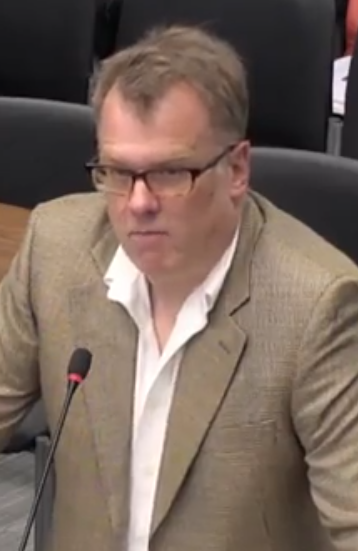 Tanner on ECoB: We exist because the voices of residents have historically had a hard time being heard at City Hall over the last decade or so. That’s the same phrase I’ve used to start the last three or four delegations I’ve made here. I say it because not everybody in the audience knows what ECoB is, and also to counter the criticism of ECoB made since its early days, and still made frequently on Twitter: namely, that we are a group of angry, unrepresentative and entitled NIMBY’s who represent nothing but selfishness.
We exist because the voices of residents have historically had a hard time being heard at City Hall over the last decade or so, and still need all the help they can get in working, hopefully collaboratively, with City Hall.
But that’s not the same thing as saying ‘what residents want to happen has to happen’. What residents want can only ‘happen’ if it’s legal. But Council can insist on Official Plan that’s ignores the wider planning context, if it wants. It has that right. I suspect that’s the subtext of today’s debate, rather than the two options actually on the table. Should council send these options back to staff for a third time and demand options that reflect what residents want? Or is there another approach that could work?
So I’m not going to do what once would have been expected from ECoB and shake my fist and say that the options presented by staff are an outrage that ignores residents. I’m also not here to capitulate and say this represents a reasonable compromise with the public vision for downtown and we simply have to put up with it. It’s not and we don’t. Downtown’s future should reflect the vision of Burlingtonians. Period. Nobody in this room should have a problem with that. The only question is, how do we get there?
I believe we have two options presented by staff which are a good faith attempt to do what they can to deliver a compromise between what residents want and what is defensible at LPAT. But those options were never going to be popular or reflect the entirety of what residents want. That was very clearly signalled by staff throughout this review. They feel it would be professionally unacceptable to draft a plan that’s inconsistent with the provincial framework.
Why do they believe this? Because of the Urban Growth Centre. That’s the root cause of this entire debate. Regardless of population targets and minimum densities and all the rest of it, while the Urban Growth Centre is in place downtown we are going to get proposals for highrises, and LPAT is going to approve them. That Urban Growth Centre was put in place with little or no consultation, and absolutely no foresight in 2007. The then director of planning was proud that Burlington was the first city in the GTHA to do so. In retrospect it seems like we were first because nobody on that council was paying attention. But that decision informs everything happening now. Everything comes back to the Urban Growth Centre.
So Council has a choice to make, and very little time to make it. The choice is – either, ONE, reject both these options and ask the planning staff for a third time to reconsider their proposals for downtown. Or, TWO, let these options go forward, acknowledging that this is not what residents want, and not what many feel they have the right to expect, but recognising that if we’re actually going to win this battle for a downtown residents like, it’s not going to be the OP that delivers it.
If Council asks staff to think again, if that’s being considered, what will happen? It will mean more delays, with no particular guarantee that staff will even then come back with options that anybody likes. And I presume it will mean the Interim Control Bylaw will be extended, possibly for up to another year. If that happens, my understanding is that council remains unable to address the Anchor Mobility Hub at the John St Bus shelter or the Urban Growth Centre. Everything that has a chance of definitively getting control of downtown remains on hold.
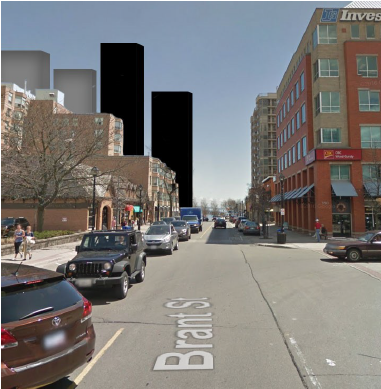 What Brant Street could look like. Meanwhile development applications keep coming in. And they keep getting taller. And while the ICBL is in place the clock keeps ticking on applications, which means those applications are going straight to LPAT for non-response by council. Far from controlling the decisions on those developments, Council is handing them over to LPAT without trying to use the tools at its disposal to achieve moderation. Those developments are not coming back to you. LPAT will make the call. I freely admit that if I was sitting where you’re sitting I would have voted for the ICBL. I have no doubt. But right about now as I see developments being appealed to LPAT for non-response I’d be wondering if I’d made a mistake. I hope I’d have had the courage to change my mind rather than doubling down.
If in contrast Council takes these options and goes ahead with them as the basis for an imperfect OP for downtown, what will happen? The ICBL will be lifted. The city can, we believe, remove the Mobility Hub and leave central Burlington with one perfectly logical transit hub, taking one tool away from developers. The city can start making decisions on the developments coming before it, and residents need you to do that work. The city can begin lobbying the province for help with the Urban Growth Centre.
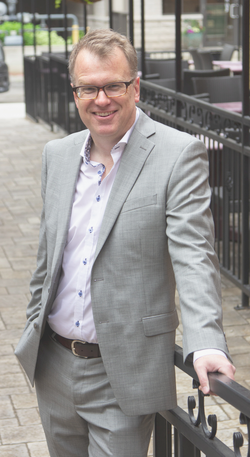 Roland Tanner sees hope for the city. Yes, we know it will not be easy, and there are numerous hurdles to achieving it. But council has something very powerful in its pocket – votes in a marginal riding. We live in a must-win riding for any provincial government, and the current government is on the wrong side of the biggest political issue in our city for this or many generations.
In that context who can say even this pro-development provincial government won’t be willing to listen?
This is EcoB’s position right now. Complete this process as soon as possible and get onto the policies which address where the real power lies. Residents ultimately don’t care about a perfect Official Plan. They care about their downtown, and they want to see a council that is doing everything in its power to address the the many things which are currently taking their downtown away from them.
And if, finally, the Urban Growth Centre can be addressed and placed where it makes sense – where Burlington’s transit already exists and growth is already being focused – could we not then return to the OP and revise it to reflect the new tools that the city holds?

 By Staff By Staff
December 6th, 2019
BURLINGTON, ON
Don Fletcher stood before a Standing Committee to tell them about a Citizens Plan for the Waterfront Hotel site at the foot of Brant street that is already in talks with the city to re-develop the site.
The Planning department had put out their proposed Concept 2 for the site. The creation of that proposal is what brought the Plan B into existence; they knew something much better was possible.
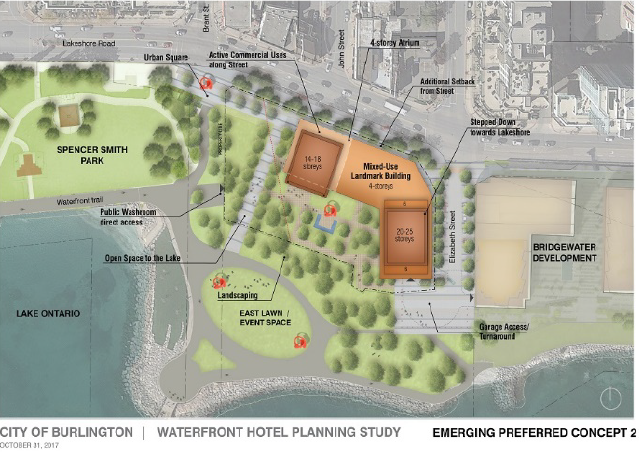 The city Planning department called it the emerging preferred concept 2 On November 28th, 2017 an alternate building design featuring:
i. Extension of Spencer Smith Park
ii. Enhancement of Brant Street gateway to Lake Ontario
was put forward.
One June 5th, 2018 another Fletcher delegation resulted in amendment to key policy direction to “define & consider a building setback from the Thin Red Line”
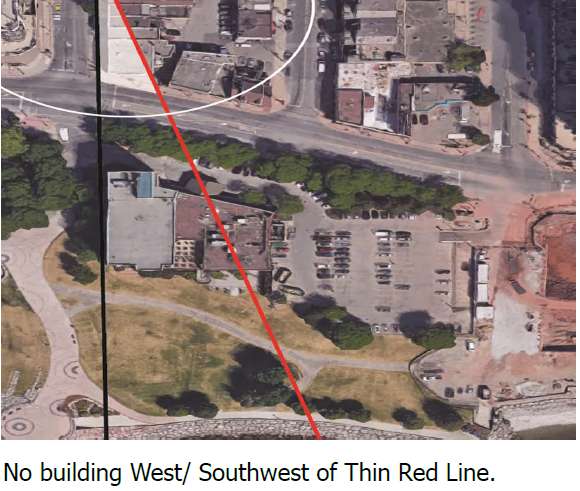 That thin red line would ensure that there would always be a clear view of the lake from Brant Street. The Citizens’ PLAN B remains committed to process, continuing dialogue with all stakeholders.
The Thin Red Line at NE Corner of Lakeshore & Brant is meant to ensure that there are no building West/ Southwest of Thin Red Line.
Fletcher explained to Council why the PLAN B folks were once again before Council.
– Two precincts, the Brant Main Street and the Lakeshore Mixed Use border on Waterfront Hotel property and Spencer Smith Park.
– That is a concern because changes to the adopted OP for downtown and the intensification designations will impact the application and approval of the Waterfront Hotel redevelopment
The participation that Fletcher saw at the Citizen Action Labs sessions caused the Plan B people additional concern about the process
The Re-examination of Adopted OP Process has a number of assumptions including key designations remaining unchanged.
– John Street bus terminal = Mobility Hub/ Major Transit Station Area
– Downtown Burlington = Urban Growth Center
• Both Concepts 1 & 2 seem designed to meet same intensification goals as former Adopted OP – LPAT defensible.
– Tall buildings permitted in Lakeshore Mixed Use Concept 1 at both NE corner w/Brant & NW corner w/Locust transition poorly to neighbouring precincts, but yield higher density
– Podium setback in Lakeshore Mixed Use Concept 2 of only 3m is to compensate for lower density of mid rise building
Fletcher believes that the electorate voted on Oct. 22nd, 2018 for fundamental change to intensification levels and the enforceability of Official Plan.
He concludes that key OP policies should to:
– Preserve connections & views to the waterfront
– House mid to low-rise buildings downtown with taller ones toward Fairview
– Maintain small town character and preserve heritage
– Reflect the community’s vision for the area
Fletcher argued that many attendees at Citizen Action Labs viewed Concepts 1 & 2 as different versions of same over-development and added that a different result from the 2018 Adopted OP demands a different approach.
Fletcher is concerned that Proceeding Solely As-Is is a mistake.
An Official Plan recommendation, potentially uninformed by the City’s Land Use Study (This is the work being done while the Interim Control bylaw is in place) was not in his opinion a smart thing to do. The land use study is not due until early March.
– Should the Mobility Hub/ Major Transit Station Area (MTSA) or Urban Growth Center designation remains they will permit the over development of the downtown which residents dislike and voted against.
This allowd for continued grounds for LPAT appeals by developers to plan/ negotiate ever greater heights. That would mean a return to “business as usual”, supported by developer-friendly Bill 108, once ICBL moratorium expires
 This is the Brant Street view looking south to the lake that the Plan B people want to ensure does not happen. Citizens’ PLAN B proposes that the city continue to refine recommended Concept (1+2)
• Create an alternate What-if Concept to support growth downtown, without Mobility Hub/ MTSA and Urban Growth Center designations
• Accelerate Land Use Study & publish
• Aggressively lobby Region/ Province to change MTSA & Urban Growth Center designations, to establish viability
• Seek public feedback (January-February)
• Present both options to Council in March
• Decide and submit OP for approval to the Region of Halton, dependent upon finalizing designations for downtown
Burlington’s Downtown is at a turning point.
Related news stories:
The first look at Plan B.
Send the Plan back.

 By Gary Scobie By Gary Scobie
December 5th, 2019
BURLINGTON, ON
You have been put in a very difficult position as a Council. You wish to please citizens with good development in our downtown, yet you feel you must also create a new OP that will kowtow to the Province’s demands and developer wishes to over-intensify the area of our city that people look to as central to our existence.
 Adjust the current OP to reflect the downtown density we really want. 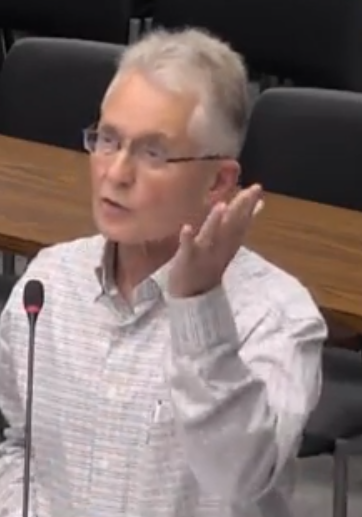 This was the first nail in the coffin for our downtown. You are in this position because of failures of past Councils, dating back to the Council elected in 2002, which threw up its hands
in defeat when trying to re-vitalize the downtown and accepted help from Big Brother in the form of the Places to Grow legislation designation of the downtown as an Urban Growth Centre. That Council and the one following in 2006 welcomed further intrusion in local planning by accepting a questionable designation of our Bus Terminal as an Anchor Mobility Hub.
That Council was more interested in saving the City by building a pier instead. Just think what they might have accomplished if they’d focused on the downtown instead, or not.
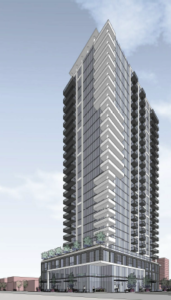 Part of the gift that kept on giving. 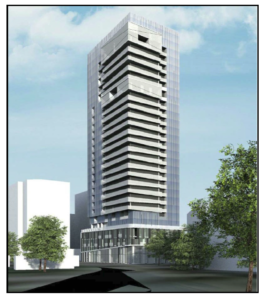 The first decision -and they just kept on coming. Fast forward to the 2014 Council who after turning down the Adi request to build a 26 storey skyscraper at Martha and Lakeshore, didn’t know how to defend the decision at the OMB and soon after in November 2017 gave Carriage Gate a gift that keeps on giving, the OK for a 23 storey building at 421 Brant that went way beyond the Op’s 8 storey limit and even beyond the 17 storey limit that was being pondered for an updated OP, all for the asking.
This was the first nail in the coffin for our downtown. Since then Council OK’d a 17 storey building at 409 Brant, again across the road from City Hall. I am almost certain that the developer-friendly LPAT will give in to the request for more height to match the 23 storeys of its neighbour across the road, leading to the Twin Towers of Burlington, a mockery of our OP and our City Hall.
Now we have before us tonight what I’d term Plan D, an attempt to please the Province, LPAT and developers with the over-intensification they desire and are prepared to fight for. And they have all the high cards in the deck and the high-paid talent to do so. No consideration of our current OP and the views of citizens who wish to keep our downtown to a human scale with retail buildings that are two storeys in height in certain areas and individual in character and façade.
When I see either of the two concepts, looking up or down Brant Street, I am reminded of a near faceless canyon of steel, brick and glass fronting sidewalks, with podiums that are a minimum three storeys in height and stores that have no character except for the name on the glass. So the D is for failure – failure to listen to citizens at labs and walkabouts like those that I attended. The D is also for Destruction because if either of these concepts (or a combination of the two) is accepted by Council, it will likely sound the death knell of our downtown, a complete replacement over time of the character we value on Brant Street.
 The Brant Street that was – can any of it be saved? But what did we expect, as developers have been buying up our retail street lots for assembly for years for a redo of the downtown in their image? With these concepts we give them free reign, with the blessing of the Province, to go beyond the minimum density goals of the Urban Growth Centre, Anchor Mobility Hub and Major Transit Station Area designations.
Developers can always claim they are only doing what the Province asked in intensifying growth centres. Unless this Council rids us of these designations we will see continued destruction of our downtown. And it hasn’t really started yet, so we have yet to realize what will be taking place. We only have vacant lots at 374 Martha and 421 Brant. Wait until the construction starts. We only have a stalled Bridgewater project on the Lake that hasn’t really impacted our congestion during construction like these others will.
But wait, there’s more. We have applications for 29 storeys at Lakeshore and Pearl, two 27 storey building applications for the Old Lakeshore Precinct and a redevelopment of the Waterfront Hotel waiting in the wings. The latter three are not even being considered in the concepts we have before us tonight. Why is that?
There is no defense possible at the LPAT by the City to stop them. So we are being sold a backup plan that can’t possibly work to save our downtown. There is only one plan that might work, but apparently we are still waiting for a report about talking to the Province to get us out from under the downtown-killing designations our previous Councils so passively accepted. We don’t need a report. We don’t need a Plan D. We need to hear from Council that it is talking now with the Province on moving the intensity away from the downtown and the Lake up to the three GO Station Mobility Hubs. In other words, put a halt on these concepts and show us some action to save the downtown.
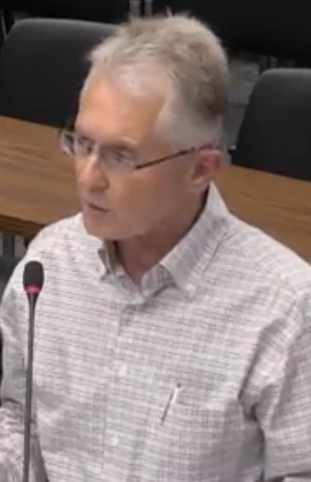 Please don’t tell us that you aren’t at least setting the stage with the Province. 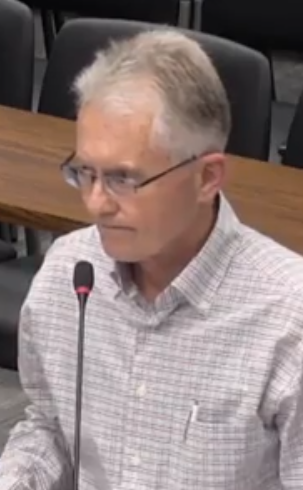 If you don’t do something with our OP, zoning and heights revert to the current 2008 version. Please don’t tell us that you aren’t at least setting the stage with the Province because the Interim Control Bylaw is in place till March. By then the timeline shows we’ll have selected a concept and maybe even a new OP. This would be like giving the enemy their ammunition.
There is one more thing that you must do as well though – adjust the current OP to reflect the downtown density we really want and the heights we would be comfortable with once we regain control of our downtown growth plan. Looking at creating a Heritage District up Brant Street to Caroline Street might also be suggested, but according to Oakville sources this is a time and effort-consuming task that may or may not fly. If you don’t do something with our OP, zoning and heights revert to the current 2008 version, the one conforming to intensification targets from the Places to Grow legislation. Only heritage buildings will be safe from being demolished unless this is done.
This is our last chance to stop many more skyscrapers from rising from Brant Street lots that will be cleared of the last remnants of unique stores and storefronts. Please don’t tell us these concepts are it – the plan to stop the high buildings. Because they aren’t.

 By Lynn Crosby and Blair Smith By Lynn Crosby and Blair Smith
December 5th, 2019
BURLINGTON, ON
Good morning Chair, Councillors, Your Worship.
I am Lynn Crosby and with me is my colleague, Blair Smith, and we represent the advocacy group, WeLoveBurlington. WLB fought against the prospects of municipal amalgamation in order to preserve and protect local voice. We are here today because we continue to advocate for local voice. We believe that Council and the citizens in Burlington are at a crucial point where we have one last chance to fight for the vision of Burlington that citizens have been expressing for years. We have one final opportunity to protect our downtown, preserve our waterfront and ensure that the people are heard.
 Lynn Crosby in conversation with a citizen. While we applaud the committed efforts of Planning staff, we would like to add our opinion to that of many of the citizens of Burlington and express both disappointment and concern with the two options or “concepts” that are being offered for the development of the downtown core. We will leave discussion of our main issues for whenever Council will be endorsing amendments to the Adopted Official Plan. We have many technical and policy arguments which justify a more popularly supported vision for the downtown – we will offer them then. This morning, we would like to speak to fundamental flaws in the concepts.
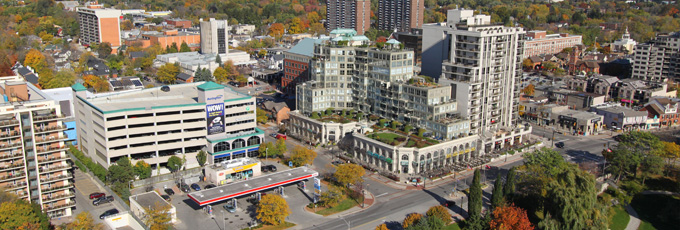 Where will the growth go? The Esso station site is reported to have been sold. WLB members attended two different sessions (hence received two different perspectives) of the recent ‘action labs’ designed to garner public opinion on what the vision and conceptual layout should be for the development of Burlington’s downtown. We also received feedback from several of our associates who attended different sessions. Notably, all sessions had the same deficiencies.
The two concepts (and the mention of a possible third melded concept) were presented – each based on the existence of the same factors or planning constraints:
The urban growth centre designation for downtown
The mobility hub located at the current bus station, and
The major transit station area designation
No consideration was given to any concept that was not based on and framed by these constraints. So, if these constraints change, and we believe that they should, then don’t the concepts also need to change? Indeed, if after the ICBL expires, and Burlington is successful in removing the classification of the urban growth centre or moving its location further north, then the limiting factors underlying the two concepts become irrelevant. Our fear is that if either of the options are selected for the downtown or anything substantially similar, then the relocation of the Urban Growth Centre becomes moot. You will be backing yourself unnecessarily into a corner that is inconsistent with your stated direction and intent.
Both concepts presented this morning are based on the Adopted Official Plan. The Adopted Official Plan reflects the direction and desire of the past Council. So, first we ask “what does this Council want?” Is the Adopted Official Plan your vision as well? The vision of the past Council, which we believe largely ignored what the people wanted for the downtown, should not automatically be inherited or repeated by you. To be fair, many of the errors made with regard to the future of Burlington’s downtown cannot be completely laid at the feet of the immediate past Council – they go further back. However, what does stand before you is the opportunity to correct these mistakes. This will be your lasting legacy.
In the ‘Action Labs,’ participants were told that the two concepts were developed because they were “defensible”. In other words, they would be consistent with the Provincial Policy Statement and satisfy the requirements of Halton Region as sole approval authority of the plan. But both concepts represent just slightly different flavours of the same thing – tall buildings in the downtown. Should there not be at least one true alternative? Participants were told that any concept that involved ‘no more tall buildings’ was not “defensible” and could not be included. So, when choosing a concept, participants selected the one that was the least offensive of the two rather than that which might actually reflect what they wanted to see.
Many participants that we questioned felt that neither concept was what was desired for downtown. Many felt that they were voting for the option that was ‘the best of a bad lot’; that even the informing vision for downtown (Section 3.3 of the Report) missed the fact, frequently expressed, that it cannot be achieved if tall buildings are part of the environment. This feeling of dissatisfaction with both process and available options is also apparent on the City’s facebook page where over 160 negative comments are registered. Overall, we believe this means any results from the polls and selections made by attendees are skewed and have little if any validity.
Perhaps the most fundamental question concerns the starting point of this process – the Adopted Official Plan. Why was this chosen when it clearly has neither legal status nor resonance with the citizens. Many who participated in the workshops had expected that this exercise was building a fresh view rather than one that merely “refines” an existing and frankly unpopular vision. Indeed, Section 3.4 of the report states that “the overall vision for the downtown remains the same”. Why? Add to this the fact that an Official Plan is intended to be read as a whole. The parts are interconnected and must be considered together to avoid taking things out of context. The downtown, which we are examining here and through this whole exercise, may be the most controversial portion of the OP but it is not the only one and each impacts the other.
WLB believes that the people need to be heard; that ‘tall building’ development in Burlington should not occur in the downtown core and particularly not in proximity to the waterfront. We will expand on this position whenever the final concept is brought back. However, we would like to be clear. WLB is not opposed to development in the interests of intensification but believes that this form of development should occur in areas other than the downtown core; if in the downtown at all, then much further north. The waterfront and our downtown are vitally important to our city and must be protected. The OP is the best way to protect them.
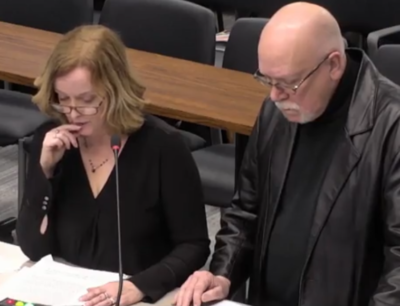 Why, wondered Crosby and Smith, was the city using the Adopted Official Plan when it did not supposedly represent the current city council? WLB believes that Council should carefully listen to the voice of the people and defend it to the best of their ability. We believe that the new OP should be redrafted to present a ‘no more tall building’ concept for Burlington’s downtown core. Indeed, what is the rush? Why are we here now? There is no deadline in the Provincial Planning Act that is forcing us to push this through without sober second thought. We have been given a “time-out” to carefully reconsider what Burlington needs and what the people want. Why are we here today at the beginning of the Christmas season, rushing to execute on a consultant’s vision for our downtown with arbitrary deadlines and time-frames for response?
We read Mayor Meed Ward’s article piece published last week in Inside Halton about the recommended changes to the OP for the downtown. We were encouraged that she feels “they still represent over-development” and that she’s “looking for an option that is more in line with what residents have expressed throughout the OP process that began in 2017.” We note that Councillor Kearns appears to have similar concerns and are equally encouraged by statements in her recent Newsletter. We also agree that the Urban Growth Centre and Major Transit Station Area designations are a concern and should officially be removed or relocated.
This whole process to date – the Action labs, the downtown tours, the surveys, the one-on-one discussions with staff and council members – is rather meaningless since it was all predicated on a direction that we believe is flawed; the premise that the popular desire for no more tall buildings at all downtown isn’t defensible and thus can’t even be considered. And why? Because we have designed these options based on the current existence of the Urban Growth Centre and Major Transit Station Area being downtown, in fact they are “givens”. A circular argument at best.
And we should neither fear nor anticipate LPAT. We believe that at LPAT the position of a municipal Council is paramount. The hearing must first understand the position of Council and the relationship between this position and the existing OP and the PPS. The type of LPAT hearing to be held and the decision resulting can be totally based on Council’s stance and direction. The new or reintroduced issue is the ‘de novo’ hearing and we will get into detail on that when we delegate next. But the critical thing is the strength of Council’s voice and the consistency of its position. A good municipal lawyer will use this to maximum advantage. This position of fearless champion of what is best for Burlington is what we expect our Council to adopt.
 Lynn Crosby and Blair Smith during their delegation: Were they heard? Finally, the result is that we feel that we are again not being sincerely engaged or truly heard. All the public engagement that has been done has landed us here in a position where the two concepts presented do not reflect what the public wants. We understand that Council will work with staff on modifications to produce an option for endorsement by early next year. This is far too important to be done in haste.
We respectfully request that Council take as long as is needed to produce the right solution for Burlington; one that protects the waterfront for generations to come and preserves a downtown free of any additional tall buildings. Please extend the ICBL if need be, complete the necessary studies, including the transportation study, the market analysis and the fiscal impact study, among others, acknowledge that the Official Plan is an integration of perspectives and should be addressed as a single entity. There is only one waterfront and one downtown – once gone there will be no bringing anything back and, fairly or not, you as a Council will be judged by the Burlington you saved or permitted to be lost.

 By Ray Rivers By Ray Rivers
December 4th, 2019
BURLINGTON, ON
Parliament and the Government of Canada are committed to the principle of making equalization payments to ensure that provincial governments have sufficient revenues to provide reasonably comparable levels of public services and reasonably comparable levels of taxation. (Constitution Act of 1982)
The communique read ‘Premiers United” but it was hardly a love-in when the provincial leaders of this great country got together at the invitation of Ontario premier Ford this week. Mr. Ford apparently had an epiphany as he watched the federal Tory leader, Mr. Scheer, fall on his own dagger. It is a different dagger than the one Mr. Ford’s provincial predecessor fell on. But there is an inscription carved in a snow bank at the back of Brampton’s city hall – Et tu Brute?
Indeed, given the circumstances of Mr. Ford’s meteoric rise to leader of the Ontario Conservatives, there may soon be an opportunity for the job he really covets.
 Which people: Ontario or the whole country? So no longer the national disrupter, that role having been usurped by messers Kenney, Moe and Pallister, Ford has donned a new persona. He now fancies himself the national bridge builder, not literally of course. Even Ford gets that being nasty and confrontational, the way Mr. Scheer was during the last campaign, is a proven recipe for failure. So today it’s ‘Mr. Nice Guy’ and tomorrow it’s the yellow brick road to leadership of the federal Tories.
It may not be just personal ambition. After all, national conciliator is a role which Ontario has played since confederation, most recently with Robarts, Davis and Peterson, leading the we’re-all-in-this-together charge. And Trudeau, having lost most of his battalion of liberally-minded provincial leaders since his 2015 election triumph, is hardly in a position to refuse Ford’s help.
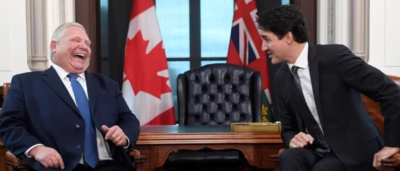 This is what “Kiss and Make up” looks like. So his kiss and make-up encounter with Mr. Trudeau under his belt, Ford clearly is out to charm the other provincial and territorial leaders, to get them to put aside the differences among them and to help him unify the nation. And nothing can unify a gaggle of subnational leaders more than a chance to pile on with grievances about the federal government. That is providing they can avoid the other big issues which might pit one premier against another.
So there was nothing in the communique about Quebec’s controversial secularism Bill 21, which had provoked a war of words… and more… between Quebec and the high and mighty Manitoba premier, who somehow thinks it is his business to intervene in an internal Quebec provincial matter.
Nor was there any mention of Alberta and Saskatchewan potentially ramming pipelines full of diluted bitumen through Quebec and B.C. to the coasts to pacify Alberta, there were a few statements about resource development with some less than subtle references to Canada’s environment assessment law. And despite Quebec Premier Legault’s objection to the increased production of what he calls ‘dirty oil’, he would sign onto anything that limited and constrained federal powers.
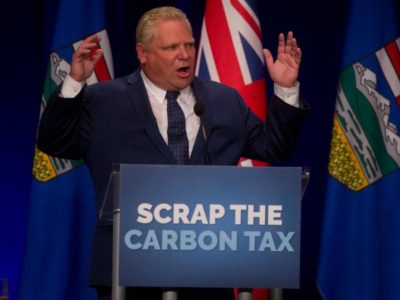 Ontario Premier Doug Ford There was no mention of the carbon tax, despite four provinces taking the federal government to various courts, including the Supreme Court, over that policy. And neither was there anything but a passing comment around climate change, the most important national issue which faced voters in the last federal election. It appears nobody wanted to provoke a stand off between the climate deniers and delayers and the other folks who actually understand the issue.
And although Albertans have been recently venting about the unfairness of Canada’s federal-provincial equalization program, there is no inkling that the premiers even discussed it. They did spend some quality time trying to fine tune the Fiscal Stabilization Program, an equally complicated multi-year mechanism intended to help provinces through rough economic patches. And as one would expect from kids in a candy store their fix was to simply demand more. Like equalization, this is federal money – somebody else is paying, right?
Equalization is one of the glues that keeps this nation together. It’s been a fundamental part of Canada since confederation though it was only formalized in 1957. And while Pierre Trudeau may have held the pen as it was being written into Canada’s 1982 constitution, equalization was initiated, formalized and most recently amended all by Conservative governments. And those last amendments which, in fact, expanded the benefits of the program to Quebecers were penned by Stephen Harper, with Jason Kenney at the Cabinet table,.
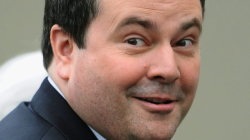 Jason Kenney So for Jason Kenney now to be talking of seriously downgrading or even ending equalization is two-faced hypocrisy. Of course we know it was a baseless threat to Quebec over a pipeline which will never be built. But it was also politics – what better way to fire up Albertan voters, using exactly the same kind of tactic Quebec separatists have employed for decades.
Alberta is by far the wealthiest province with the greatest fiscal capacity in the country and also the one with the lowest taxes. Per capita income is 30 to 40% greater than the Canadian average. And that has hardly changed even after the oil patch experienced its big price shock a couple of years ago.
And as for Quebec, the lion’s share of the equalization budget does go that province, but given its population Quebecers receive the smallest share per capita among all the have-not provinces. Albertans may look at Quebec with some envy though. After all, it has balanced its budget. That has to do with its fiscal management and its degree of taxation, almost twice as much as Albertans pay. And unlike Alberta, the province also manages both a child care and pharmacare program.
Quebec’s pharmacare program, implemented in 1997, is a two-tiered system, similar to Ontario’s OHIP+ (youth pharmacare) – except it applies to all ages of Quebecers. It has received accolades from the Fraser institute claiming it “offers better drug coverage and quicker approval for new drugs coming to market than the rest of Canada.” In fact the plan covers twice as many pharmaceuticals as Ontario does.
But drug costs are higher and rising rapidly, particularly for the public tier of the ledger. Canada’s expert panel on pharmacare rejected the Quebec model, recommending a single payer system as a more efficient (lower cost) and sustainable option. In any case, some premiers, such as Manitoba’s Pallister, aren’t willing to even entertain the notion of a universal pharmacare program.
Pallister, much like Ontario’s Ford, has an intractable problem with hallway medicine in his province’s hospital wards. And like Ford, his prescription is turbulent restructuring, cost-cutting and eliminating health care jobs. So Pallister, like Ford is looking for more federal money to get him out of the pickle jar in which he has placed himself. That is a negotiating tactic – he’ll not agree to pharmacare unless it comes with a Santa-sled of new cash.
 NDP leader Jagmeet Singh Quebec, and possibly Alberta, can be expected to opt out of any national pharmacare program, regardless that the alternative would be more costly. So getting to a universal pharmacare program across the country may be as much of a pipe dream as Mr. Kenney piping his province’s diluted bitumen across la belle province. Still pharmacare was at least given honourable mention in the final meeting communique. And it is the gun which Mr. Singh is holding to the prime minister’s head.
The next step in Mr. Ford’s unifying process involves the premiers meeting with Mr. Trudeau. But nobody should hold their breath waiting for any kind of unity coming out of that meeting either. If you do you might end up in one of Mr. Pallister’s hospital hallways.
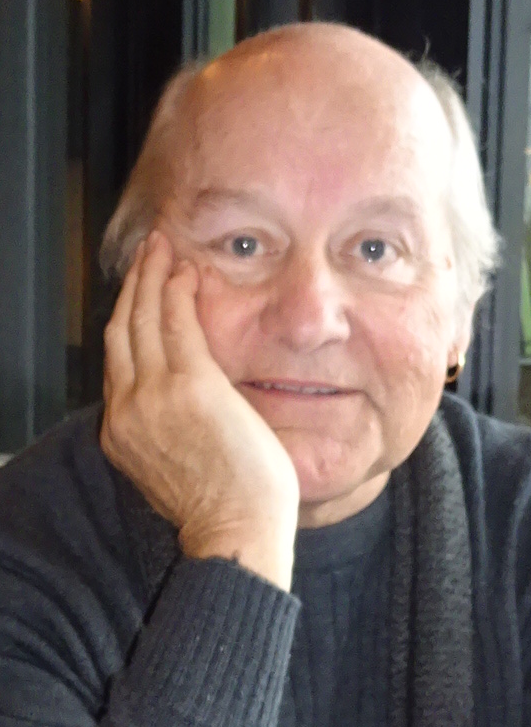 Ray Rivers writes regularly on both federal and provincial politics, applying his more than 25 years as a federal bureaucrat to his thinking. Rivers was once a candidate for provincial office in Burlington. He was the founder of the Burlington citizen committee on sustainability at a time when climate warming was a hotly debated subject. Ray has a post graduate degree in economics that he earned at the University of Ottawa. Tweet @rayzrivers Ray Rivers writes regularly on both federal and provincial politics, applying his more than 25 years as a federal bureaucrat to his thinking. Rivers was once a candidate for provincial office in Burlington. He was the founder of the Burlington citizen committee on sustainability at a time when climate warming was a hotly debated subject. Ray has a post graduate degree in economics that he earned at the University of Ottawa. Tweet @rayzrivers
Background links:
Premiers’ Meeting – Fiscal Stabilization – Alberta Economic Stats –
More Economics – Equalization – Kenney Equalization – Quebec Drug Plan –

 By Pepper Parr By Pepper Parr
December 3rd, 2019
BURLINGTON, ON
It was a year ago this evening – the new city council was sworn in.
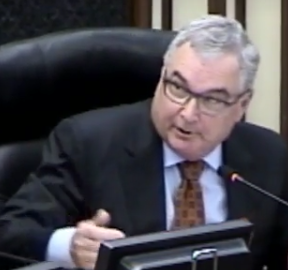 City Manager James Ridge is shown the exit door. The next day the Mayor called a Special Meeting of Council and got their approval to fire the city manager.
There were other changes in the wind. The Council’s first budget increase was modest – but the Mayor had to convince her Council to shake $4million out of the hydro Reserve Fund.
That this was going to be a different council was made evident the night the Goldring Council held its last meeting. Meed Ward had some comments she wanted to make – Mayor Goldring politely advised her that comments were not permitted at that point. Marianne Meed Ward stunned the Mayor and the City Clerk that she wanted to speak on a point of personal privilege. While the Clerk was shuffling through the Procedural bylaw Meed Ward gave her a copy with the appropriate section marked.
And then she let blast. The full report of that meeting is linked below.
Paul Sharman was the only holdover from the 2006 through to 2018 terms; the others either resigned or were defeated. ( In 2010 every council member was re-elected.)
The other five were new to municipal politics. They had basically zero political experience and several had to struggle but they learned the ropes and little by little we began to see where there was some talent and where some help was going to be needed.
There was a new city manager who had served the city in the past; he was known, well-liked by most and was able to bring some stability to an administration that had gone through a very difficult period of time and knew that there were many rough months ahead.
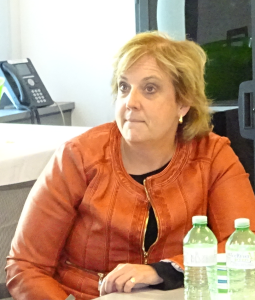 Mary Lou Tanner’s job disappears – she finds the exit door. The Deputy City Manager was shown the door; there was a new Chief Planner with a team that needed help and support.
The learning curve for the five new council members was steep; some are not doing all that well. Some have surprised us while others have been a disappointment.
What is evident is that this Council is pulling together and doing so rather well.
Collectively they are taking on huge issues – Climate Change was a challenge they did not shirk.
The opportunities to do things that were badly needed were embraced and while there is a lot that is not yet known – the outcome, whatever it is, will not be because this council didn’t try.
The members of council are learning the strengths and weaknesses of their colleagues; they are as well learning which Staff members are straight shooters and which are not to be relied upon all that much.
None of the five had any idea that the experience they are having is what they imagined the day they submitted their nomination papers.
The city’s downtown core is under an Interim Control Bylaw which means nothing moves forward until the research and the deep thinking is done.
 Official Plan gets re-write. 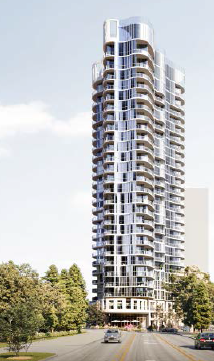 Might work in Mississauga – not wanted in Burlington. The re-write of portion of the Official Plan is taking place – with the Planning staff trying every idea out there to involve the citizens.
Some stunning developments have been brought forward; all of which would be embraced quickly by Mississauga – but Burlington is not Mississauga.
Council has to come to terms with wanting to do everything and what fiscal reality will permit. There are only so many Reserve funds that can be raided.
At this point council deserves to be told publicly that we appreciate what they are trying to do and wish them well as they enter their second year of their four year term.
A closer review however is merited.
The day Meed Ward let the outgoing council have it right between the eyes.
Salt with Pepper is the musings, reflections and opinions of the publisher of the Burlington Gazette, an online newspaper that was formed in 2010 and is a member of the National Newsmedia Council.

 By Ray Rivers By Ray Rivers
November 30th, 2019
BURLINGTON, ON
Today it’s just a small group of young folks, one only 12 years old, taking the provincial government to court under Section 7 of the Canadian Charter of Rights and Freedoms, which promises protection for life, liberty and security of the person. Yet, according to the science, they more than the 55 year old Mr. Ford, will suffer “widespread illness and death” because of the policies of this provincial government.
 Doug Ford: cancelled virtually all of the positive environmental policies of the previous government, as if the environment is a partisan issue. Even the federal government, which had pioneered a number of progressive climate measures, including the carbon tax, is being sued (by another group of young Canadians) for not doing enough. But Mr. Ford’s government is clearly culpable – having actually cancelled virtually all of the positive environmental policies of the previous government, as if the environment is a partisan issue and he needed to show he was different. So it’s as if Mr. Ford deliberately provoked this kind of reaction, the first such legal action against a provincial government.
Ford slashed the province’s carbon emissions reduction targets. He is suing the federal government at the Supreme Court over a carbon tax, imposed only after he cancelled the province’s own cap-and-trade carbon pricing program – the most cost effective way to reduce all of the peoples’ carbon footprints.
While taking credit for the results of the provincial innovative green energy program, which reduced Ontario’s climate damaging emissions by 22%, Ford has bragged about having shut down the program. Coal which was used to produce 25% of the province’s electricity in 2003 was phased out by 2015 and largely replaced by conservation, wind and solar power.
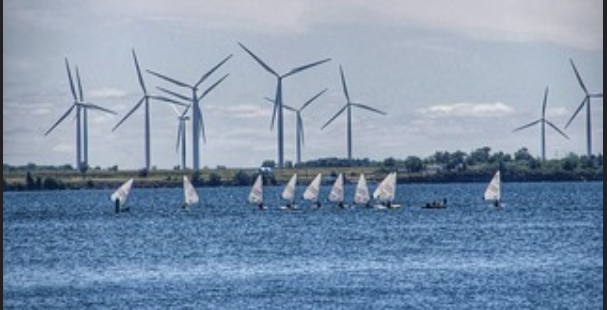 Some see the wind turbines as a pleasant addition to a skyline But Mr. Ford doesn’t like the sight of wind generators, so he has killed some 800 renewable energy projects undergoing completion. It is costing a quarter billion dollars to cancel these investments. This action winds down the development of renewable energy in Ontario and with it the thousands of jobs already in the wind and solar industry. Canadian Solar, for example, used to be the third largest global solar manufacturer.
Mr. Ford has also declared war on electric vehicles, and reduced the pump price of gasoline, thus encouraging greater gasoline consumption. He ended the provincial electric vehicle (EV) incentive program and killed the program of installing EV charging stations across the province.
Mr. Ford says he believes in climate change and has a plan to deal with it, but that is clearly rubbish. Just ask those young people suing him or all the people in this province who voted federally for political parties supporting the carbon tax.
And this goes beyond climate change. In 2005 Ontario issued 15 smog advisories covering 53 days, due in large part to pollution from Ontario’s coal-fired electricity. An independent study estimated the health, financial and environmental costs of that pollution at $4.4 billion a year. More recent studies have shown that exposure to nanoparticles emitted in automobile and truck exhaust fumes can also lead to a number of health effects including a rising number of cases of brain cancer.
 This is not the way to determine who governs us. Litigation is today’s new democracy. As we’ve previously discussed in this column, the inadequacies of our first-past-the-post electoral system cry out for electoral reform. In the absence of that reform we have to rely on the courts to ensure politicians listen to the people between elections. So we should expect more legal action – individuals suing government and governments in turn suing industry to recover the costs of the health care and environmental damage and costs they cause.
Current emphasis on environmental litigation has been likened to what has happened with the tobacco industry. Those damage law suits were less about the fact that cigarettes are addictive and cause cancer and heart disease, but that the companies knew all of this and misled or withheld it from the public and public health authorities.
There is substantial evidence that oil company researchers and executives understood that the ongoing expansion of petroleum consumption would lead to irreversible global warming. Not only did they fail to inform the public but deliberately misled all of us. And isn’t the imperilment of the planet’s climate a crime for which no punishment is too harsh.
 Another voice, Canada’s Ecofiscal Commission, recently concurred with other experts that its analysis demonstrates that carbon pricing is the most cost-effective way for the country to hit its 2030 Paris emission targets. Of course they argue that the price would need to rise to $210 per tonne compared to $30 today. And then former Ontario Liberal environment minister Glenn Murray, who introduced Ontario’s cap and trade carbon pricing program, now believes that it is too late, even for a carbon tax to be effective. Another voice, Canada’s Ecofiscal Commission, recently concurred with other experts that its analysis demonstrates that carbon pricing is the most cost-effective way for the country to hit its 2030 Paris emission targets. Of course they argue that the price would need to rise to $210 per tonne compared to $30 today. And then former Ontario Liberal environment minister Glenn Murray, who introduced Ontario’s cap and trade carbon pricing program, now believes that it is too late, even for a carbon tax to be effective.
 Ray Rivers writes regularly on both federal and provincial politics, applying his more than 25 years as a federal bureaucrat to his thinking. Rivers was once a candidate for provincial office in Burlington. He was the founder of the Burlington citizen committee on sustainability at a time when climate warming was a hotly debated subject. Ray has a post graduate degree in economics that he earned at the University of Ottawa. Tweet @rayzrivers Ray Rivers writes regularly on both federal and provincial politics, applying his more than 25 years as a federal bureaucrat to his thinking. Rivers was once a candidate for provincial office in Burlington. He was the founder of the Burlington citizen committee on sustainability at a time when climate warming was a hotly debated subject. Ray has a post graduate degree in economics that he earned at the University of Ottawa. Tweet @rayzrivers
Background links:
Youth Legal Challenge – Ontario Coal – Wind energy –
Air Pollution – More Air Pollution – Canadian Solar –
Car Culture – Oil Legal Cases – More Oil Legal –
Carbon Tax Too Late –

 By Pepper Parr By Pepper Parr
November 25th, 2019
BURLINGTON, ON
Recall those occasions when you put two and two together and realize that the total is five?
 This crew will probably not be clearing the leaves from your property. They were working along New Street when this picture was taken. Keep that in mind as you look through what we have written about the Loose Leaf Collection Program and read the comments carefully.
Could it be that City Council is giving serious thought to the idea of killing the program as part of a tax saving measure?
The program is expensive and no matter that the city does – something goes wrong.
 Why not just get rid of it early in their term of office; give the native’s time to get used to the idea and boast about how you have managed to keep the budget at just a pinch above the 4% increase last year. Why not just get rid of it early in their term of office; give the native’s time to get used to the idea and boast about how you have managed to keep the budget at just a pinch above the 4% increase last year.
If that doesn’t fly – how about a Loose Leaf Collection levy?
This is a story that still has some legs – let’s see where the tail that wags the dog takes us?
Salt with Pepper is the musings, reflections and opinions of the publisher of the Burlington Gazette, an online newspaper that was formed in 2010 and is a member of the National Newsmedia Council.

 By Ray Rivers By Ray Rivers
November 22nd, 2019
BURLINGTON, ON
If you are a political follower like me, you would have been glued to the TV watching the US House of Representatives impeachment hearings for the last two weeks. It is the best entertainment on the tube – better than the latest season of the Crown. And the Democrats have been brilliant, unfolding their story so there can be no doubt about Trump’s guilt in his latest attempt at corruption.
Call it quid pro quo, bribery, international blackmail, breach of trust, abuse of power – take your pick or tick all the boxes. It’s corruption – dishonest or fraudulent conduct by those in power, typically involving bribery. And Trump will almost certainly be impeached by the House of Representatives, though politics being what it is south of the border, he is unlikely to be removed from office.
Corruption seems to be contagious these days. Trump’s closest ally, Israeli PM Netanyahu, has also been indicted for corruption. But at least he didn’t betray his nation’s security as Trump has been doing since his election, given all the irrefutable testimony of the last two weeks.
 Donald Trump with Ukrainian president Volodymyr Zelenskiy. Trump has been accused of withholding military aide until Zelensky opened an investigation into Joe Biden who wants to run against Trump in the 2020. Few countries can hold a candle to the former Soviet republics when it comes to corruption, and Russia and Ukraine in particular. So Trump figured – what’s a little more corruption – they must be used to it? Or maybe he was just trying to please his master in Moscow.
Canada has had its own share of corruption. Stevie Cameron’s best seller, ‘On the Take’, gives an uncontested accounting of the slime we’d seen over the Mulroney years. And don’t forget the former PM accused of accepting brown paper bags full of cash from that Karl Heinz character. Of course there was the Sponsorship scandal which ultimately kept the Liberals out of power for almost a decade and at one point relegated them to third party status.
Andrew Scheer thought he had hit pay dirt, letting rip accusations of corruption and criminality at Mr. Trudeau over the SNC prosecution. But it turns out there was no smoking gun, just a lot of smoke. Mr. Trudeau had been cited by the Ethics Commissioner a couple of times and he has apologized at least once. But then even mild mannered Stephen Harper ran up a sizeable laundry list of potentially impeachable offences.
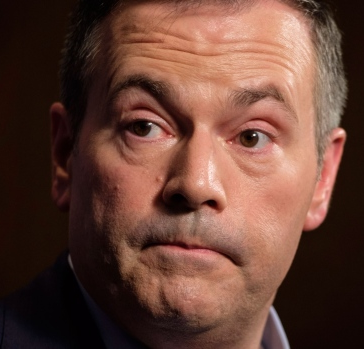 Jason Kenney fired the province’s elections commissioner who was investigating just how Kenny got elected. The latest unwinding of Canadian corruption takes us to Alberta and Jason Kenney. When the province’s elections commissioner investigated some of Kenney’s dirty tricks getting to office, and charged him with over $200,000 in fines, Kenney just borrowed a page from the Donald Trump’s playbook and fired him. And when opposition leader Notley objected, the speaker kicked her out of the legislation and the majority Conservatives just let Kenney off the hook.
Doug Ford had brazenly attacked the Kathleen Wynne government as corrupt. But he must have known that was pure fiction. Indeed the Liberals had an imperfect record during their decade and a half in power, and especially regarding McGuinty’s gas plant mess. But there was no corruption. Even the former premier’s budget numbers were proven to be accurate, at least in light of the auditor general’s observations.
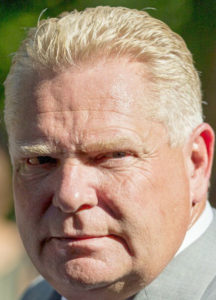 Are the people who voted for Doug Ford experiencing buyers’ remorse? Ford’s popularity has tumbled in Ontario – it’s called buyers’ remorse. Anyone expecting the PC’s to better manage the treasury can’t be happy that the deficit is now climbing to over $2 billion more than it would have under the Liberals this year, despite Ford’s best efforts to slash and burn public services. And that slash and burn will end up in a war in the not too distant future as teachers and other public service employees confront ignorance and a lack of respect from this hostile government.
Ford has been boasting about his other war, the one on the environment. He is proud of how it only cost taxpayers an additional $200 million dollars to cancel and roll back some 800 renewable energy projects. But didn’t Ontario voters support climate action in the last federal election. His actions mean that our growing electricity demand will now have to be supplied with climate damaging natural gas.
And speaking of climate change, tax payers are on the hook for as much as $2 billion dollars a year since Ford cancelled Ontario’s cap and trade carbon pricing system. And we’re also paying for his $30 (plus) million ideological court battle with the feds over the carbon tax – which everyone knows he will lose.
There is no better example of the Ontario government’s abuse of power than forcing every gas station in the province to stick a political message on their pumps. Fortunately the labels seem to want to fall off. Having managed his family’s label making company, one would think that labels would be the one thing Ford could get right.
The Ford government has even messed up the cannabis file having wasted over $40 million dollars this year and failing to get an effective private distribution system in place. The Liberals had planned to use the experienced and profitable LCBO by contrast. Instead something like 80% of the province’s cannabis is still delivered through the blackmarket today.
Given the Ford family’s history around Ontario’s drug culture, one would think that pot would be the other thing he’d be able to manage without screwing up. One can only speculate into whose pockets some of that $40 million went.
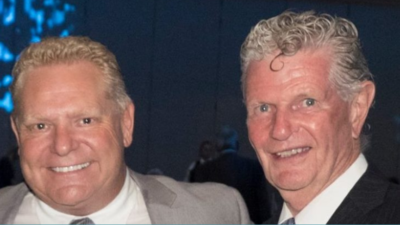 Doug Ford poses for a picture with Ron Taverner, his first nominee for Chief of Ontario Provincial Police. We all live in glass houses when it comes to calling out corruption and it wasn’t long before the cracks started appearing in Ford’s. So far it’s only been a little bit of patronage, nepotism and cronyism. But he has still got two and a half years to go.
Particularly troubling is his government’s intention to muck with judicial appointments. As we’ve learned from the US impeachment hearing, that is perhaps the number one source of Ukraine’s corruption. Can we really trust this government to avoid that pitfall? Can we really trust this government?
Background links:
Israeli Corruption – Mulroney – Harper –
Alberta – Ontario Budget – Ford Cronyism –
Ford Cannabis – Black Market Pot – Politicizing the Judiciary –

 By Tom Muir By Tom Muir
November 15th, 2019
BURLINGTON, ON
At a November 4 meeting of Committee of the Whole, transportation staff was giving Council Committee an overview of their five year business plan for Transit.
Councilor Sharman had read the report carefully and he had major problems with some of the numbers. He didn’t like the math, and he had some very challenging words to staff on what he thought.
Subsequently, he made a motion to forward the staff report to the Council meeting Agenda of Monday, November 18 for further scrutiny and discussion. This motion was carried 5-2.
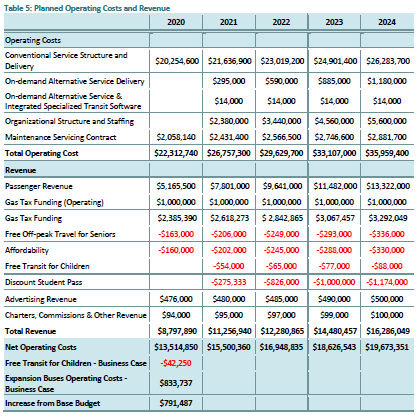 The disputed Table 5 It will be interesting to see what happens at this meeting and how Council responds to his concerns and position. This analysis and startling assessment of a staff report, by a Councilor, is very unusual in my experience and is what motivated me to write this opinion piece.
“The numbers are all completely wrong, and there are a number of things where they don’t make sense”; “Table 5 is completely wrong”; are the gist of what he was reported to say in a story by the Burlington Gazette.
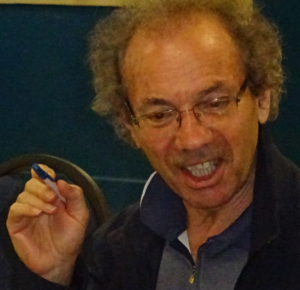 Tom Muir – if there is a flaw in your data – he will find it. Since I was a citizen member of the City Development Charges Consultation Committee that considered the transportation and transit service plans, and I had expressed serious concerns of my own to this Committee on the transit plans and unfunded costs to 2031, and Councilor Sharman was the Committee Chair, I reached out to him to ask what was behind his serious concerns and the words he chose.
I found we had a lot in common in our views of what is really a complicated situation that is a big deal in its own right, but in particular, for laterals to the City Budget, which happens to be under review right now.
Significantly, the stated focus on Table 5 of the 5 year business plan report goes to the heart of his discontent as the Table summarizes the finances of the 5 year business plan – Planned Operating Costs and Revenue, wherein you can see the bottom line Net Operating Costs, dollars that need to be mostly funded from somewhere in the Budget, going from about $13.5 million to almost $20 million annually from 2020 to 2024.
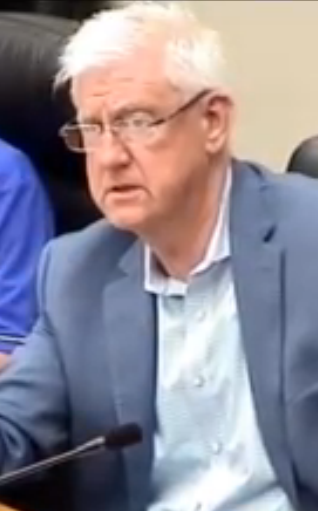 Councillor Paul Sharman And peering a little closer into some line items you can see another possible alarm bell in the fact that the Operating Costs are comparatively “hard”, if implemented, but the Revenue estimates, which are based on the assumed ridership associated with the services provided by the costs, are decidedly “soft”, and to the both of us, not believable.
As far as I can discern, neither Mr. Sharman nor I have any idea where this growth is going to come from, and this was also discussed at the DC Committee meetings. This is also being pushed by the Halton Region in their DC study to increase the modal split by assuming it can be done.
In our discussion I think the crux of the matter is shared – the lack of a rationale to show how the transit system configuration proposed will work to provide real results. Remember, this is a Business Plan, and it seems obvious that such a thing should have a firm evidentiary foundation in support of an expectation that it will work.
Mr. Sharman put it this way; I summarize
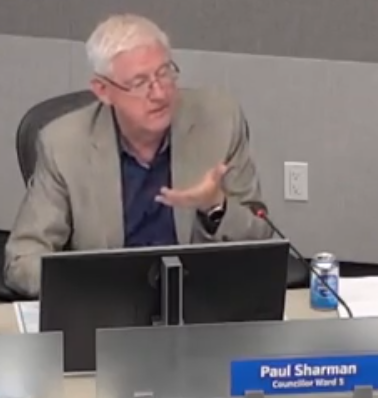 Councillor Paul Sharman explaining what was wrong with some of the data in a transit report. 1. There was no assessment of the Burlington market, economic factors, routes (maybe 80% of ridership is all routes 1 and 101), long term history of transit numbers, forecast City demographic change and ridership mix impact.
2. Burlington ridership and routes are not much different than they were 20 years ago i.e. primarily between Burlington and Hamilton south of the QEW. The report has no analysis of ridership split between handivan and regular buses routes. Presumably, since we have been adding handivan buses and drivers, and with the increasing elder population % ridership growth the projected growth would be worth knowing.
3. The numbers in the report are entirely unrepresentative of anything to do with Burlington. The report is entirely premised on Region of Halton Modal Split targets for the next 5 years and from there calculating what ridership numbers would have to be in order to meet the 5 year target, which is 23% average growth per year.
4. The consultant then used Canadian Urban Transit Association standards to determine what that meant in terms of how many more buses, drivers, maintenance staff, overhead staff and facilities would need to be added to the budget in each year going forward. CUTA standards are aspirational goals that have been demonstrated to not actually represent any Burlington peer municipality (Jeff Casell, Waterloo University 2012). They are more representative of highly intensified big city circumstances.
5. So when you look at the numbers in the table provided, it shows that the 23% average will be highly front end loaded with a 36.5% growth in year 1 of the plan, i.e. from 2,000,000 riders in 2019 to 2,730,000 in 2020. When Mr. Sharman challenged the consultant on the number he was unable to explain the distribution.
6. The critical concern in this is not so much the report per se, but that that the 2020 budget for the City of Burlington includes funding to purchase 4 new buses and hire 8 new drivers. The report proposes that the City should do that in each of the following four years at a cost of $millions each year. Keep in mind that 1% increase in the City of Burlington budget equals $1.6m. Further, that transit revenue, presently, represents less than 25% of operating cost.
The risk is that that the City is about to pour all sorts of real hard dollars into a plan that is completely devoid of any substantive analysis, ridership projections or realistic plan.
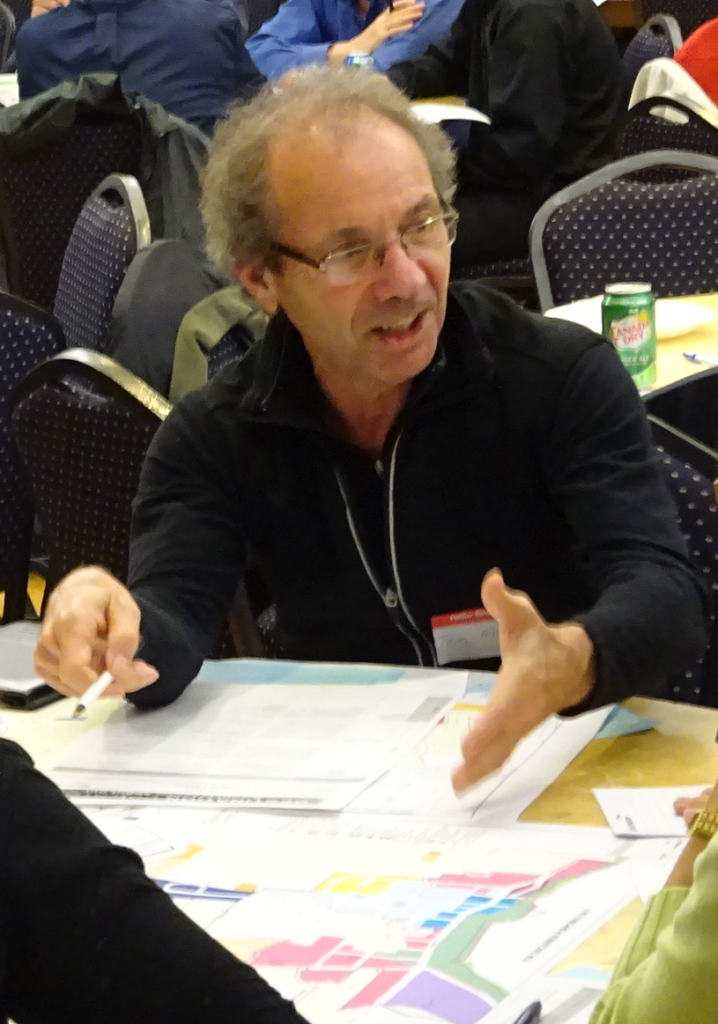 Looking for a Plan B. We want to see a Plan based on a modal split that is realistic, and will work to service the needs and wants of residents without forcing people onto buses, or blithely assuming they will walk or bike (doubling from 5 to 10%; remember winter?)), and there will be fewer cars.
Is there a Plan B, and what form does it take? What rational criteria or indicators are being used to stage or trigger additional service supply, and when do you stop or lag additions? What constitutes success?
What about “failure”? – remember the biking trial project failure (New Street Road Diet) ; and stagnant transit ridership, at a 2% modal split, that must be completely reversed and exponentially energized upward continuously by 600% by 2029-2031 or so?
For most of my needs, the bus doesn’t go there. Walk, and bike and bus all you want, but most people basically have to drive to survive in Burlington and surrounds. It’s called needs, and work, and distance, and time, and family and so on in reality.
How to get to Costco, Walmart, Longos, Fortinos, Sobeys, Clappisons Corners, Terra Landscape, Connons Garden Center, Canadian Tire, and so on.
The bus doesn’t go there. I need a case of beer, a lawnmower, lumber, groceries for a week, hockey for the kids, music lessons, all of this on Saturday, etc. etc. Try walking, biking or busing this stuff there and home.
For most commuters, except as noted for route 1 and 101, the bus doesn’t go there I believe.
I have never sensed a significant latent demand for such a transit service on the part of the majority of residents.
These are big decisions you have to make that are interrelated and not explained.
Have you done financial risk assessment for all costs? When do you stop the experiment? Do you have a fail-safe mechanism?
Remember, Burlington cannot fund transit from Development Charges (DC) – the transit plans to add services are considered to be largely “benefits to existing” residents. So there are large cost additions to be funded, and very small contributions for transit from developers as part of the ever-growing need for transportation services due to growth in Burlington and Halton Region. Also remember the provincial policy drivers that are forcing a renewed Grow Bold, at higher cost to the city.
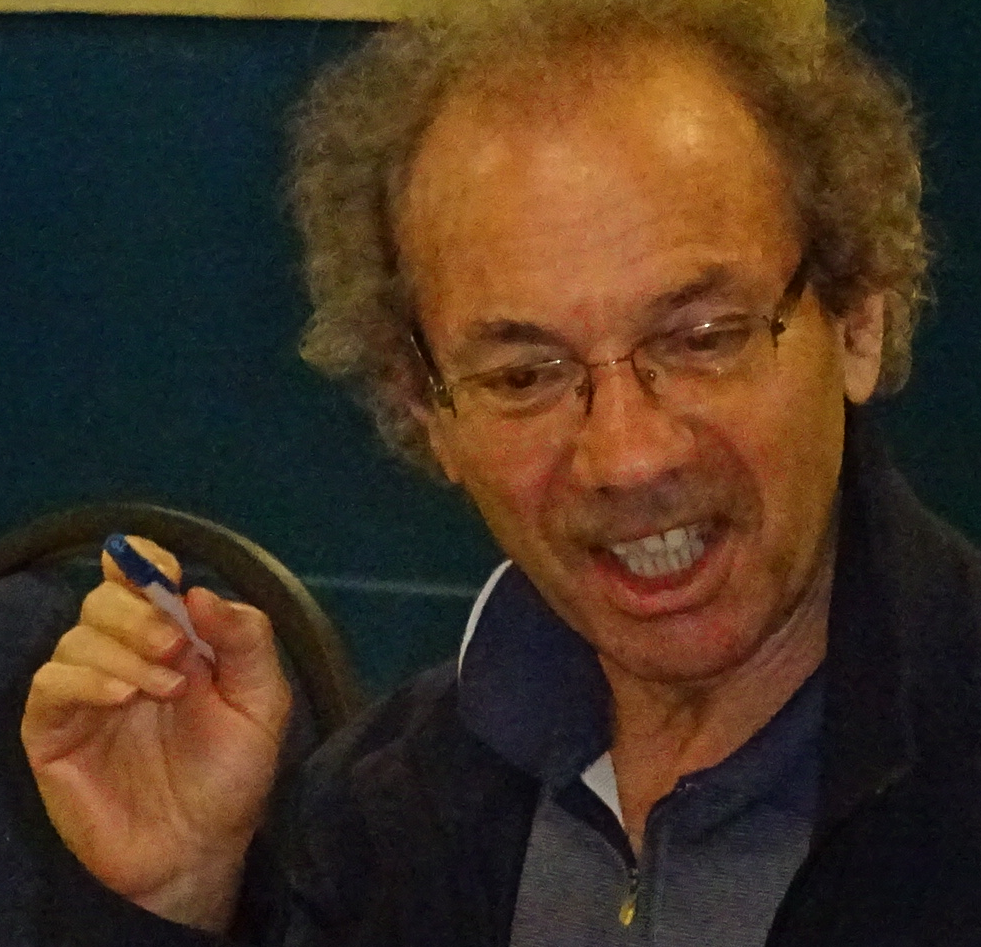 Tom Muir – uses a sharp pencil when looking at numbers. It’s time that this transit cost burden on the city, and not the development responsible, be reconsidered or the transit plans will not be sustainable and fully funded, which is what the transportation staff have said is needed and the goal.
In conclusion, If staff are going to direct the city to implement the transit and transportation quantitative plan identified, and Council agrees to approve this, with all the costs identified with no visible tracking of results, and triggering of rational incremental system steps based on results, and financial risk assessment and management controls in place, then they must be held transparent and accountable for showing how it is realistic and founded on evidence, visible trends, and realistic/rational possibilities for changing the behavior of city residents in the substantive way described.
I was told that this issues set identifies an area where we have to improve and that’s communication. I believe we’re looking for the same things and that’s a sustainable, funded transportation system that moves us (likely slowly) away from total auto dependency over the long run while keeping in mind that the auto is still the primary mode of travel.
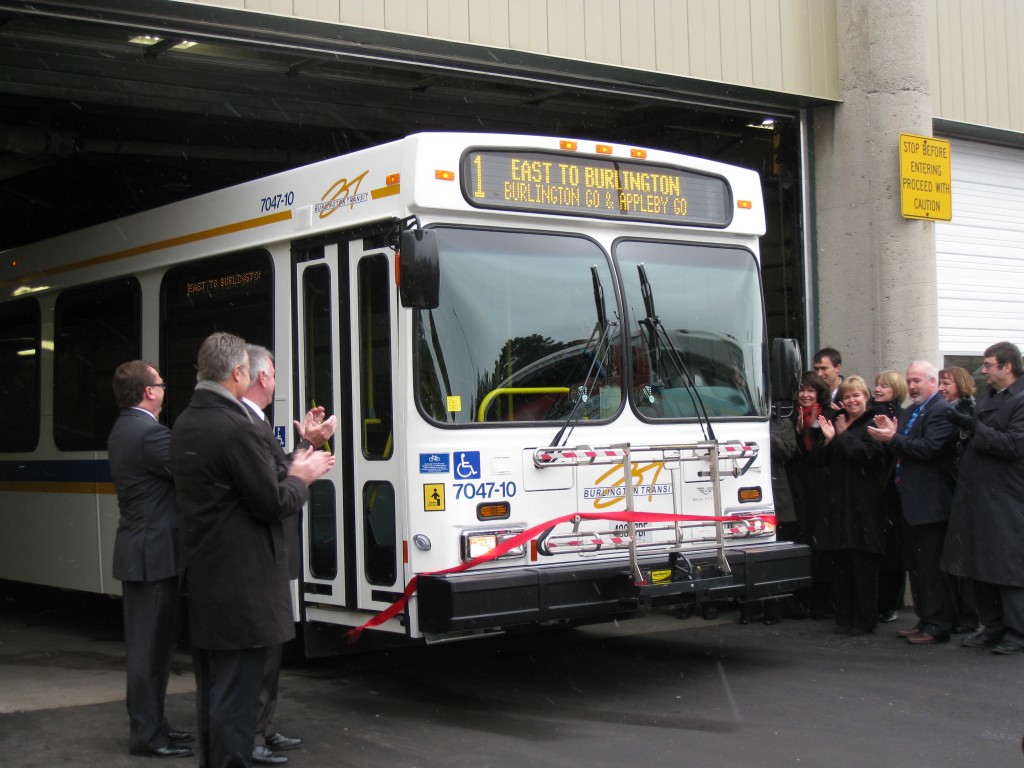 Couple of million in high priced talent welcoming a new bus into the fleet. You can buy and supply all the buses you want, but getting people to demand and use these is an entirely different matter, conceptually and practically. I don’t think it legitimate to try and force people into acceptance of a rejigging of their lives.
I see nothing presently, or moving forward from this, that shows awareness of what the actual problem is other than attributing it to people not liking it or the change. The change is not the problem. It’s the change based on impossible levels of different behaviors people are expected to manifest for no reason.
I see no fact-based explanation for why people should or could use a significant and costly increase in transit and pay the estimated large cost share, as calculated. I support some transit increase, but I see no demonstration and evidence-based reasoning to support what I see here, never mind the DC Plan to 2031.
This needs evidence, and not just rationalization, to show how the transit system configuration proposed will work to provide real results.
All I have seen so far are assumptions that people will somehow and magically change.
Finally, remember a basic principle governing any planning exercise is; “that everything that starts with a faulty premise is bound to fail”
Editor’s note: Mayor Meed Ward has said she wants transit to be free for everyone. Factor that into the Muir comment and the Sharman point of view.
Related new story:
The numbers didn’t add up.

|
|








































































































